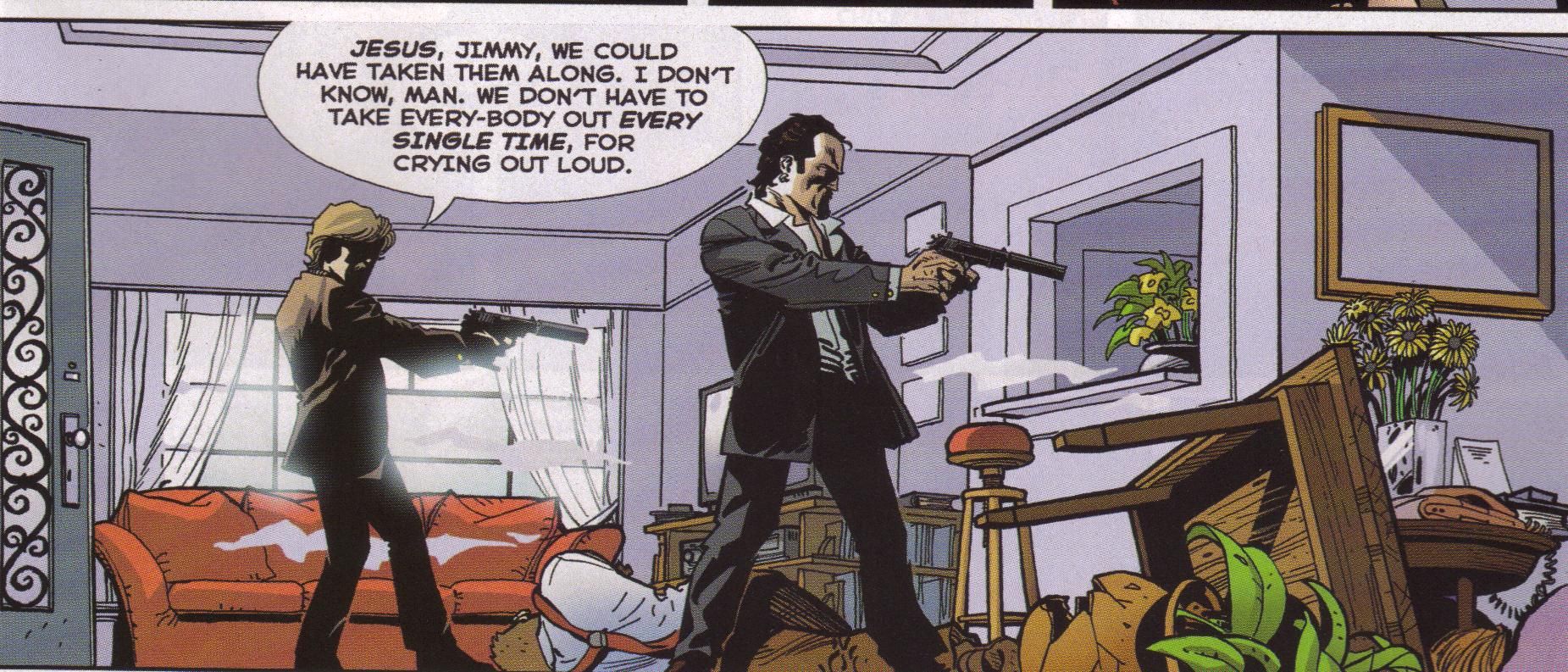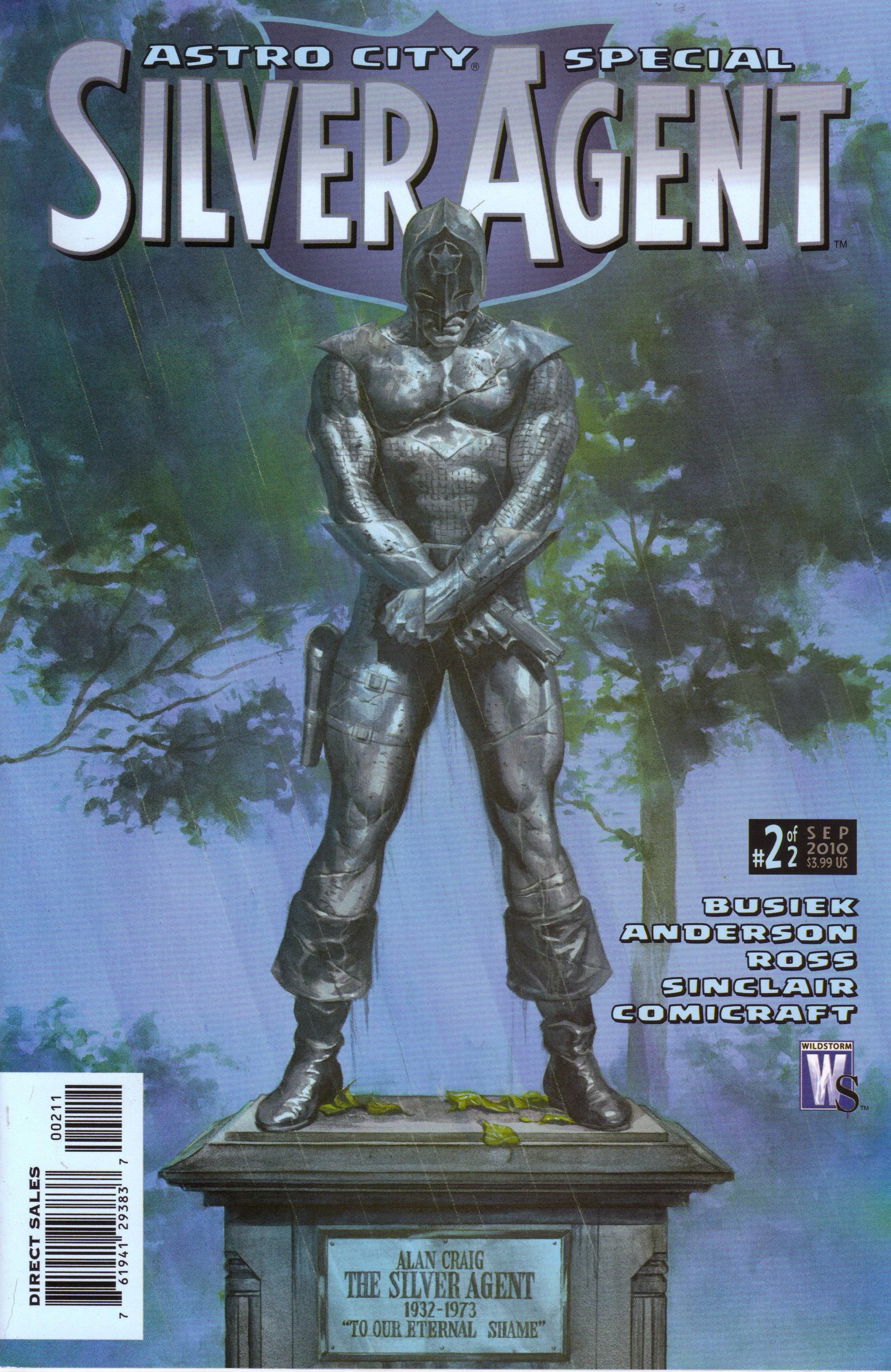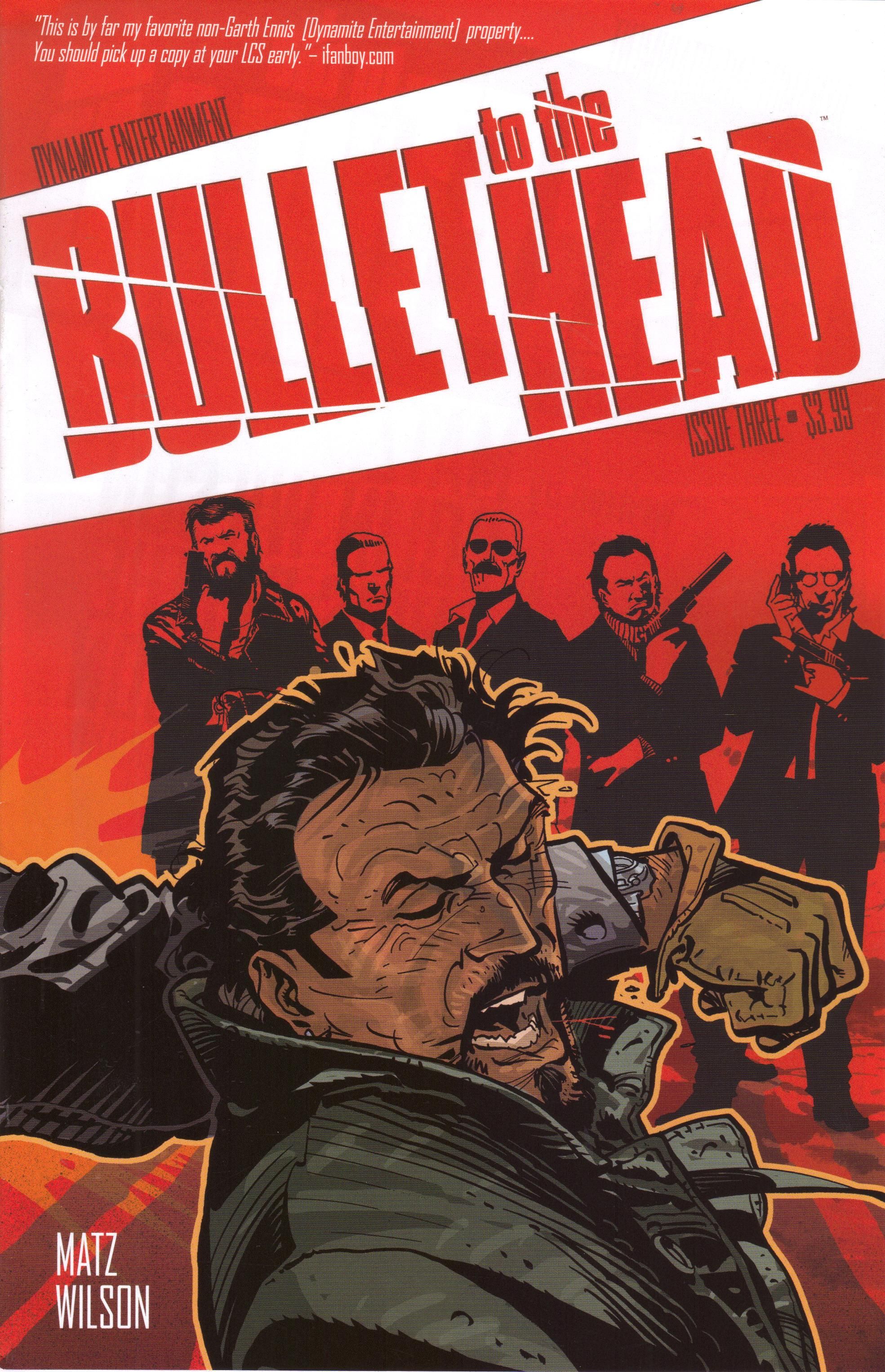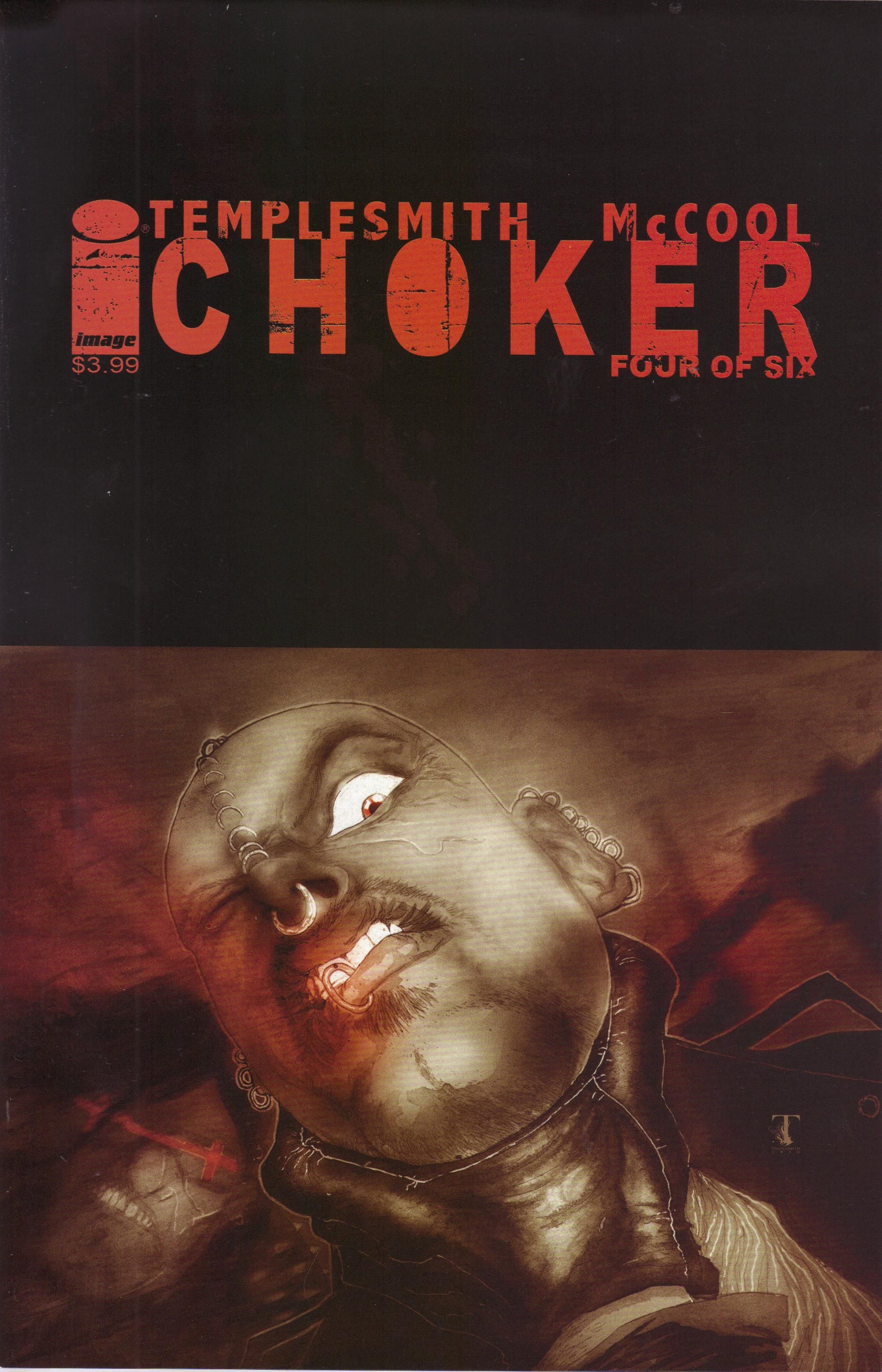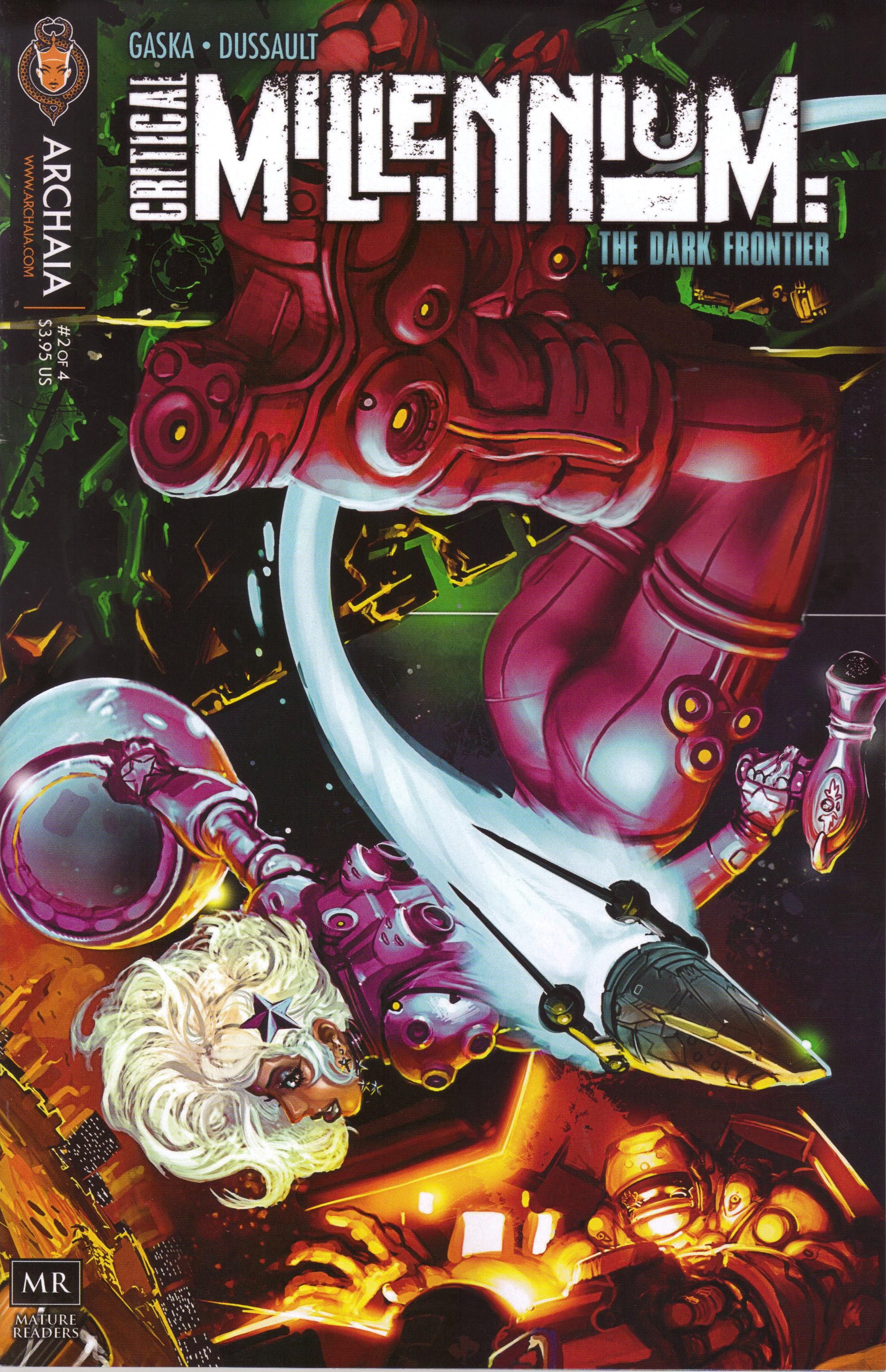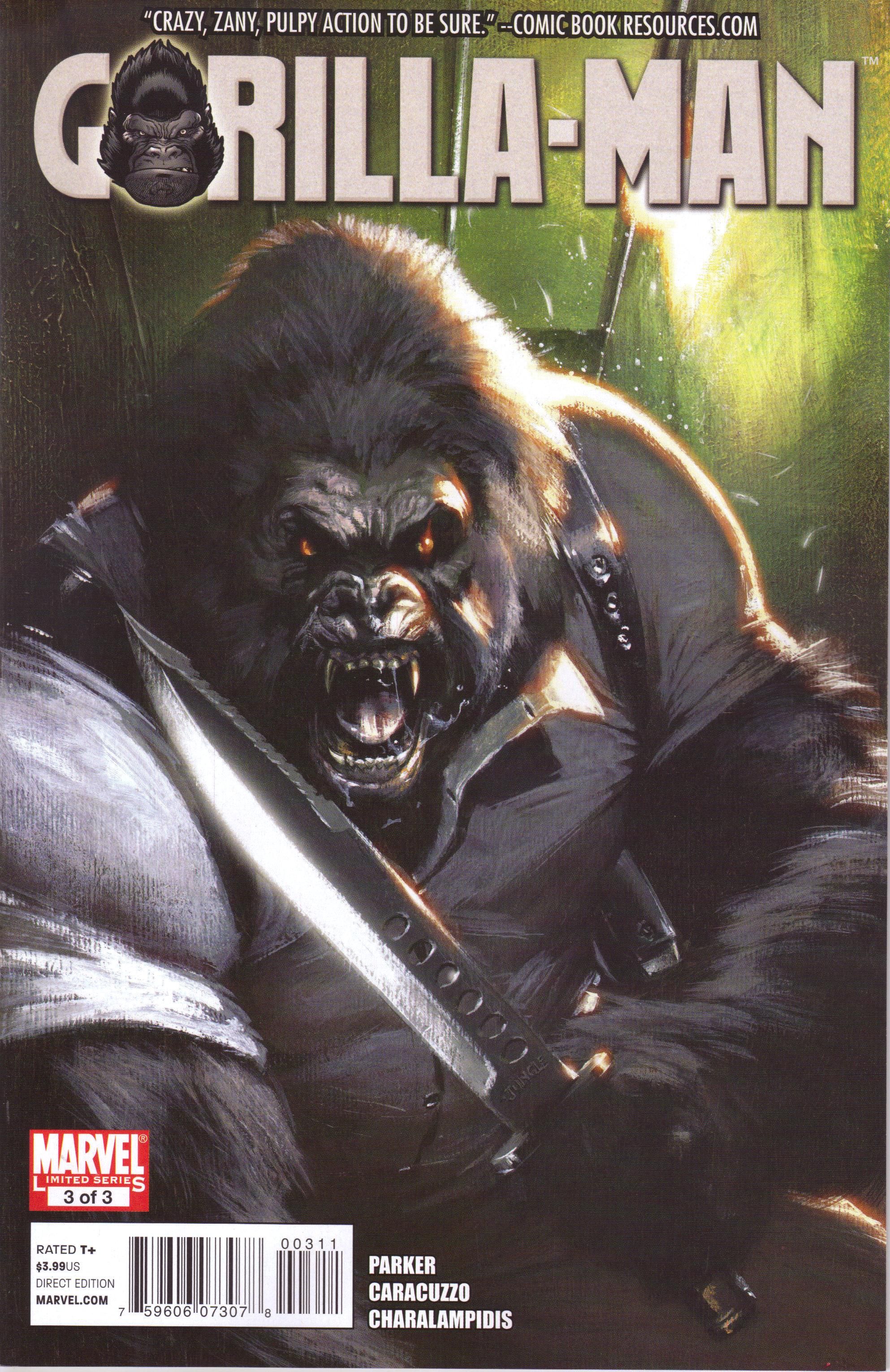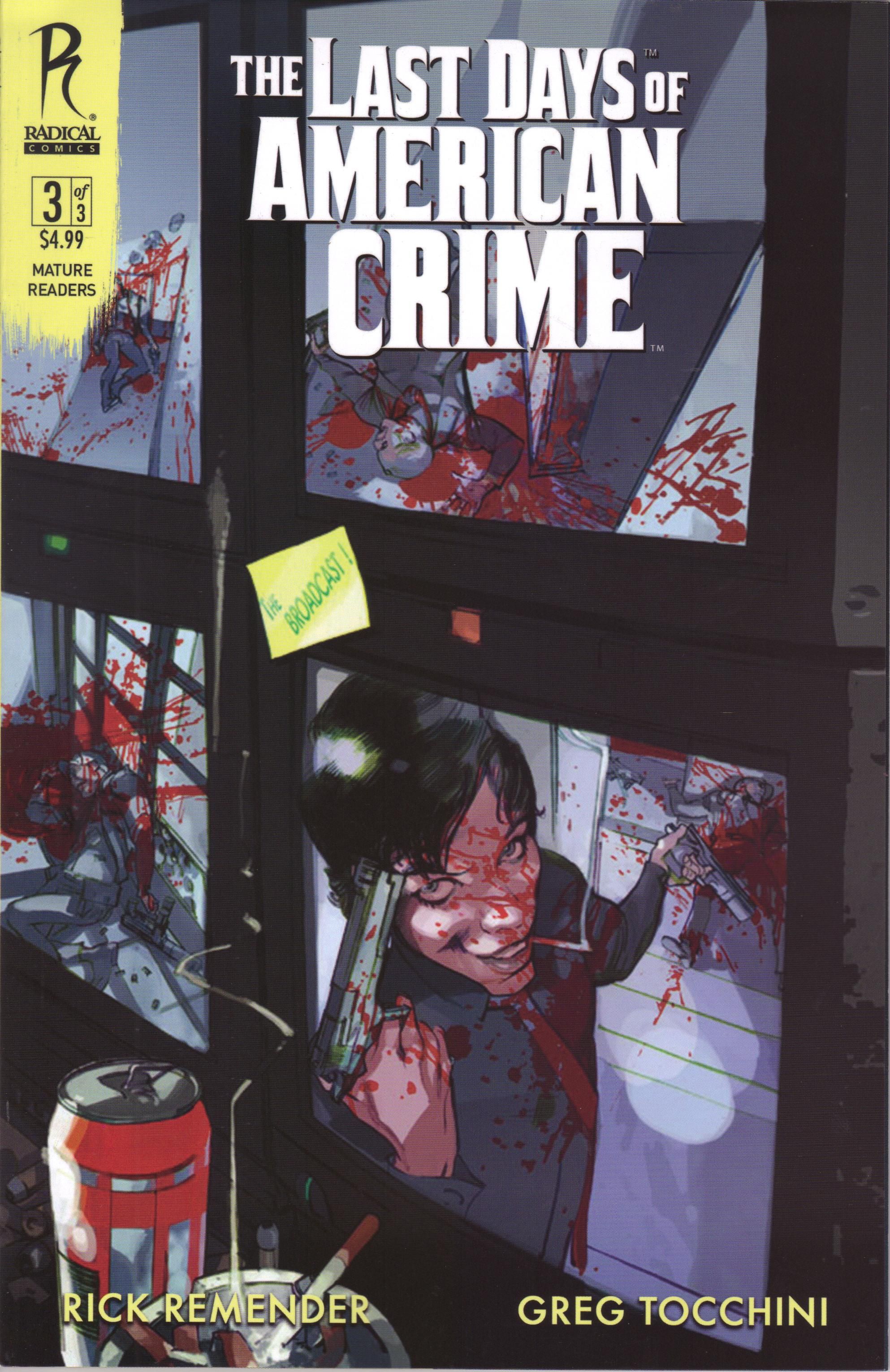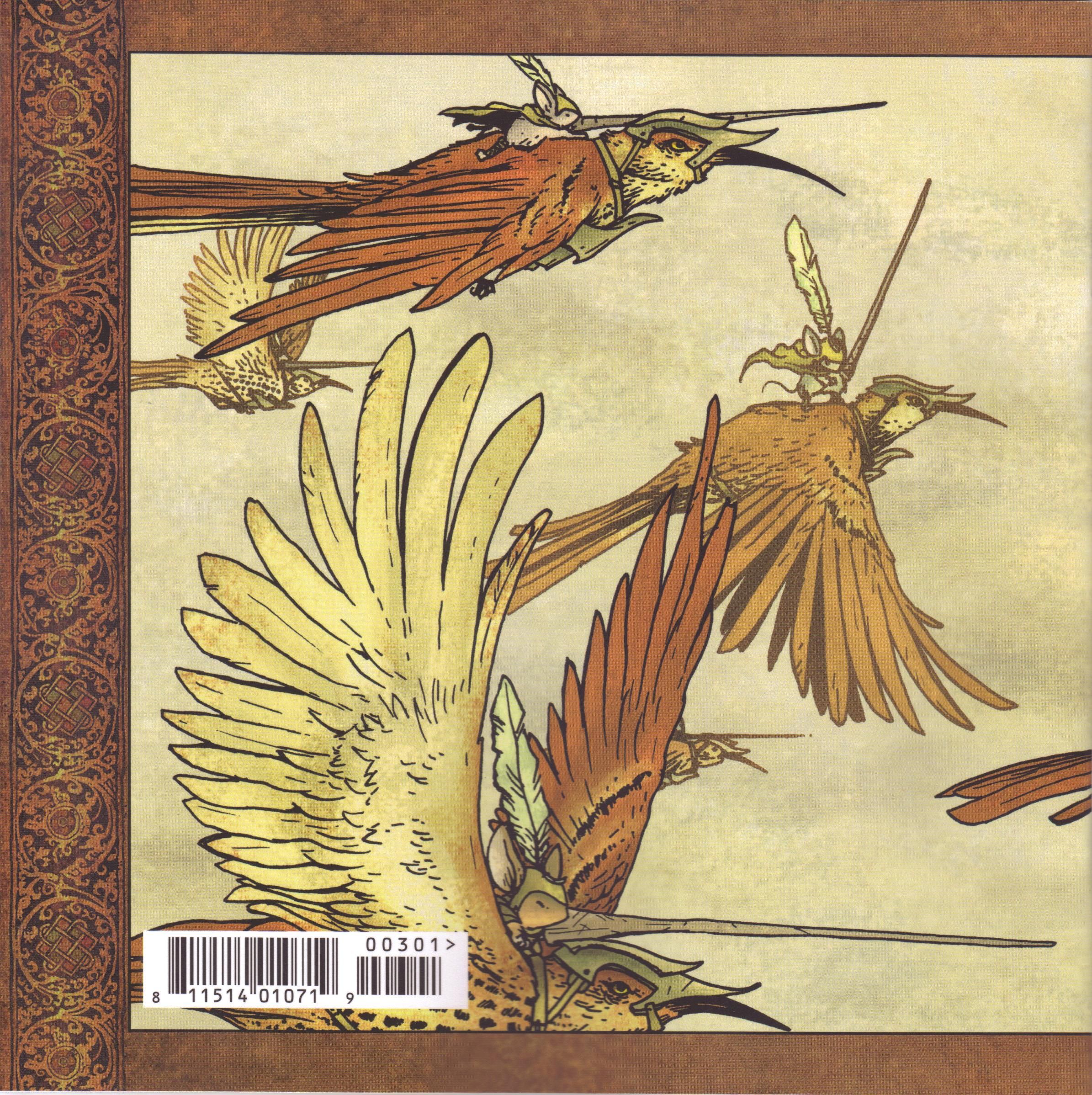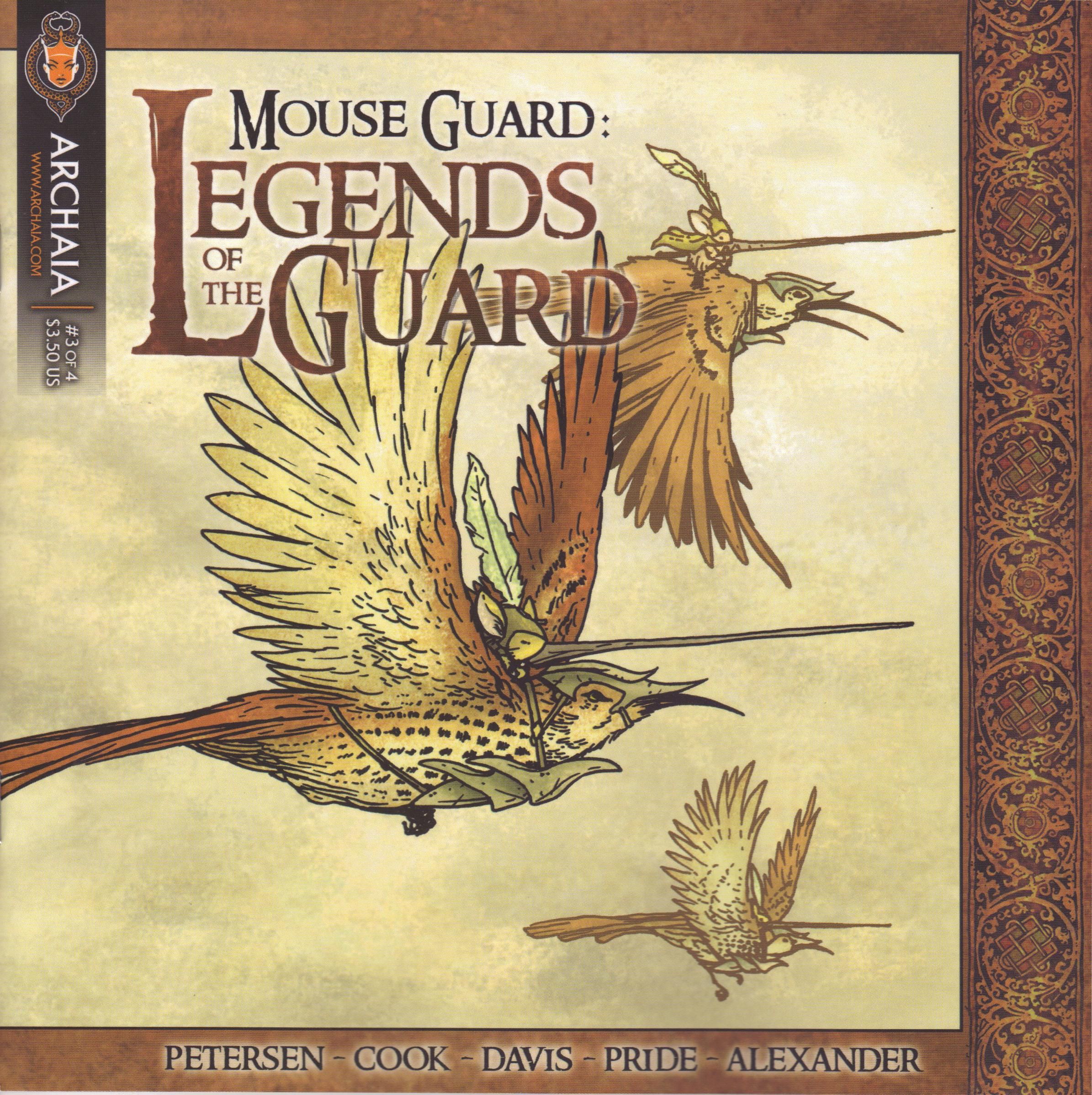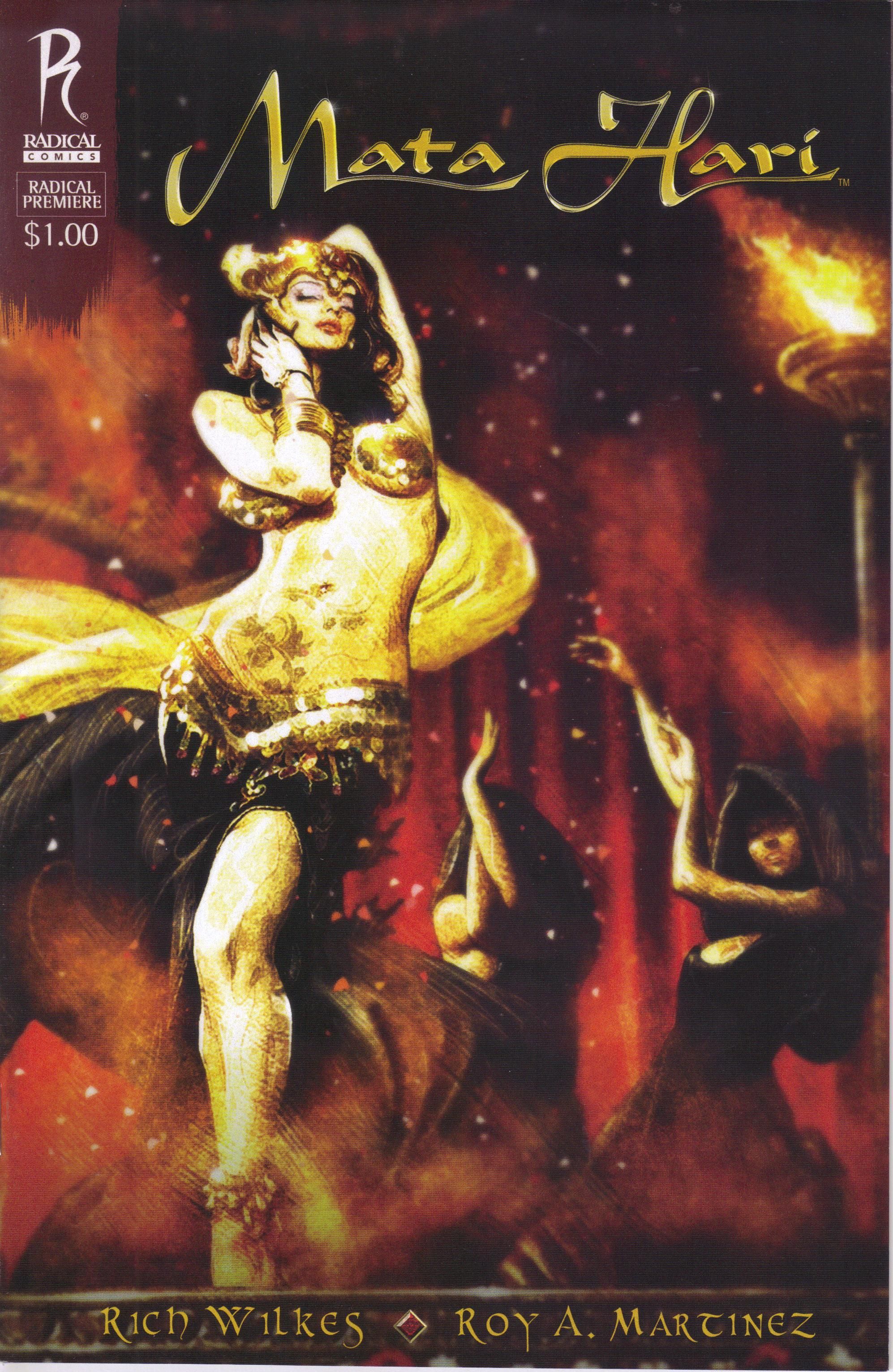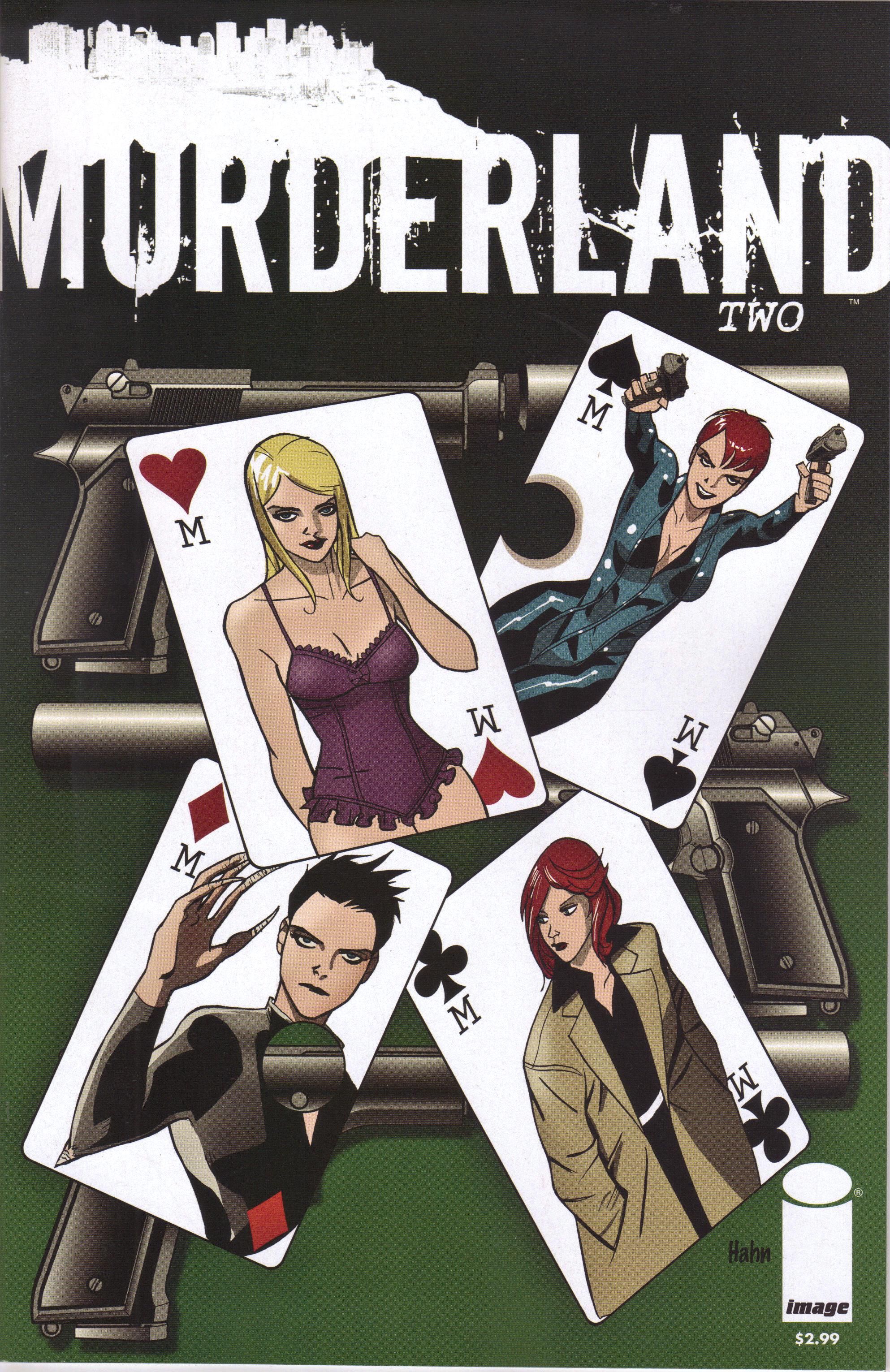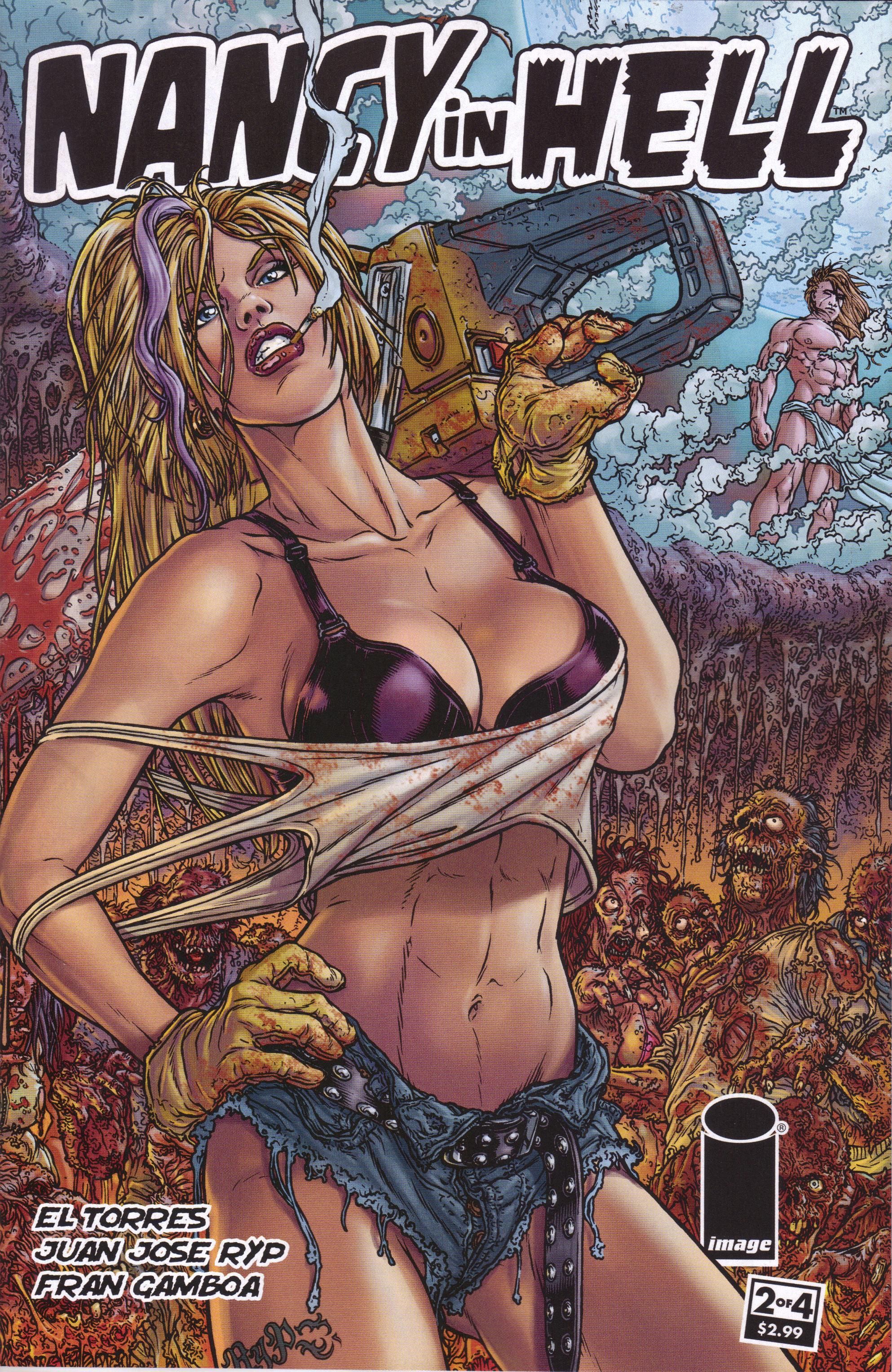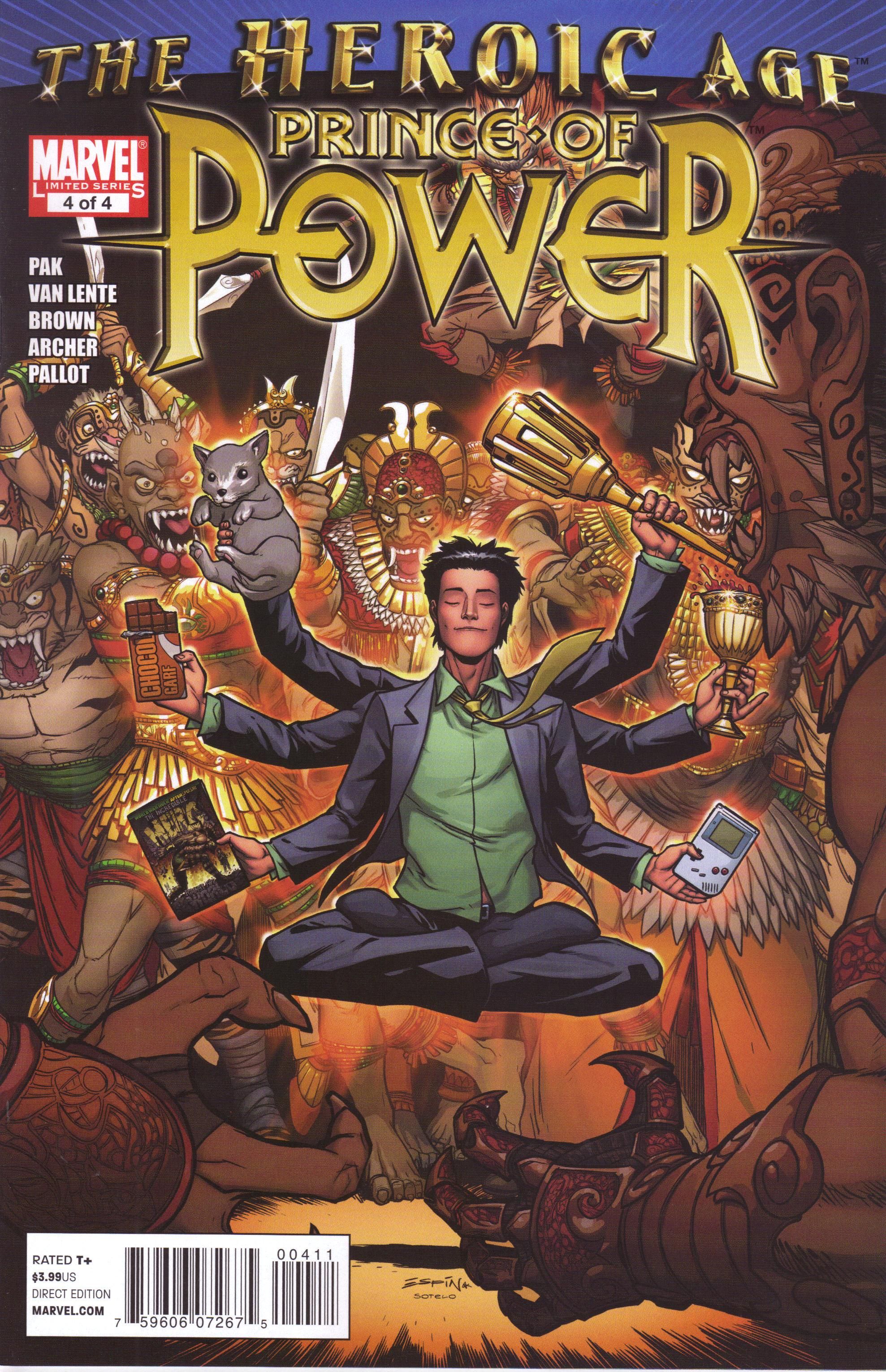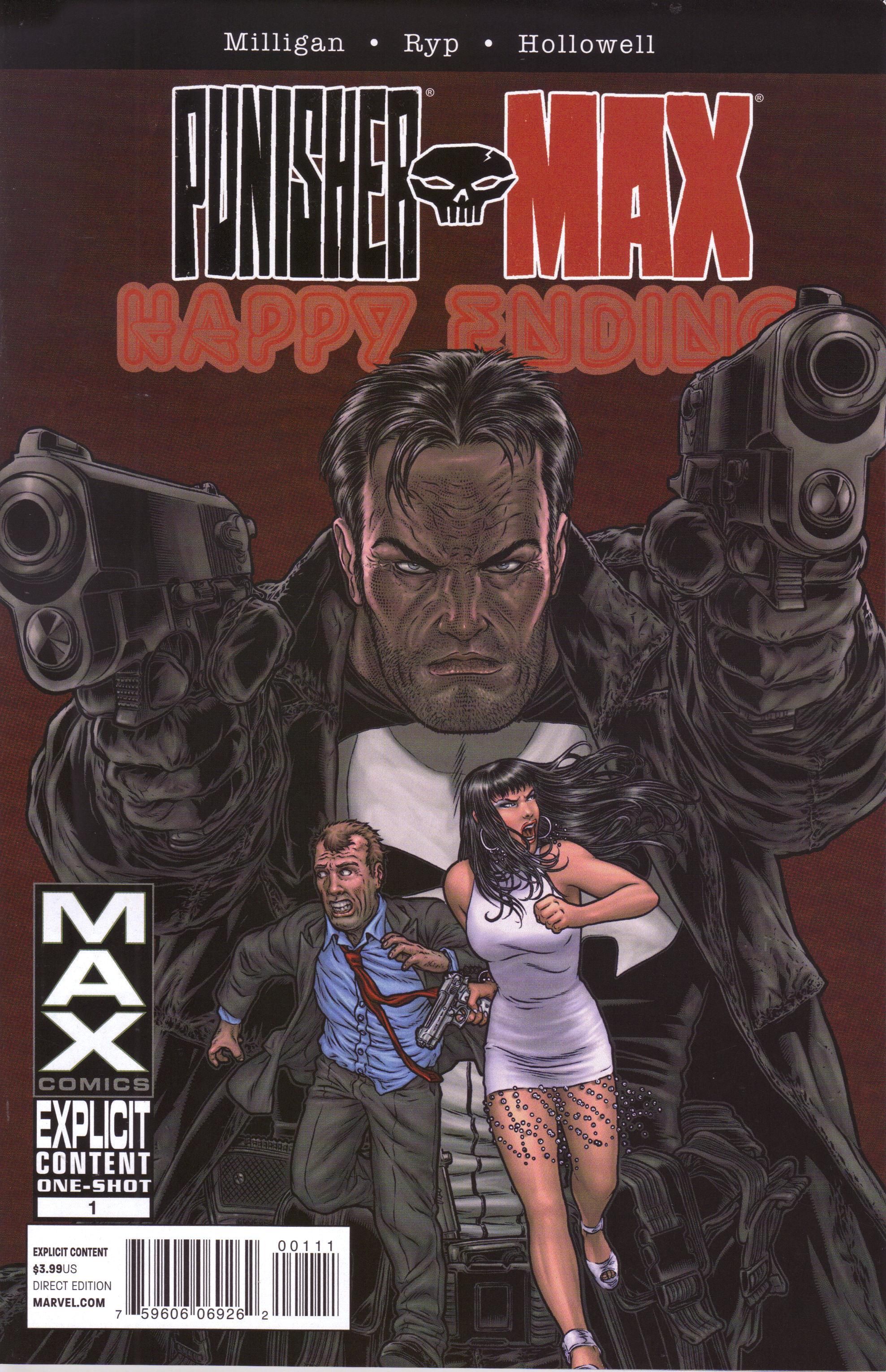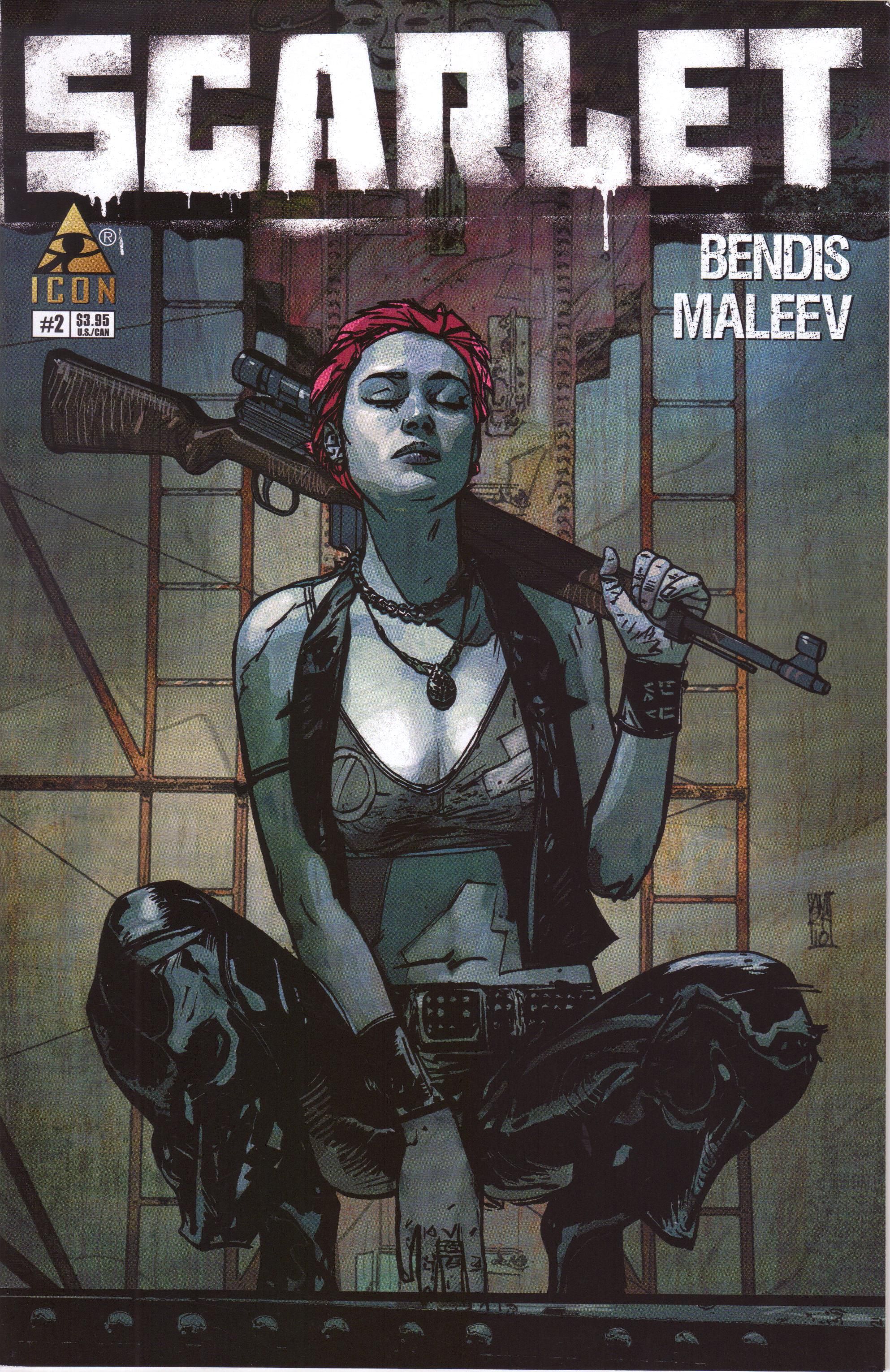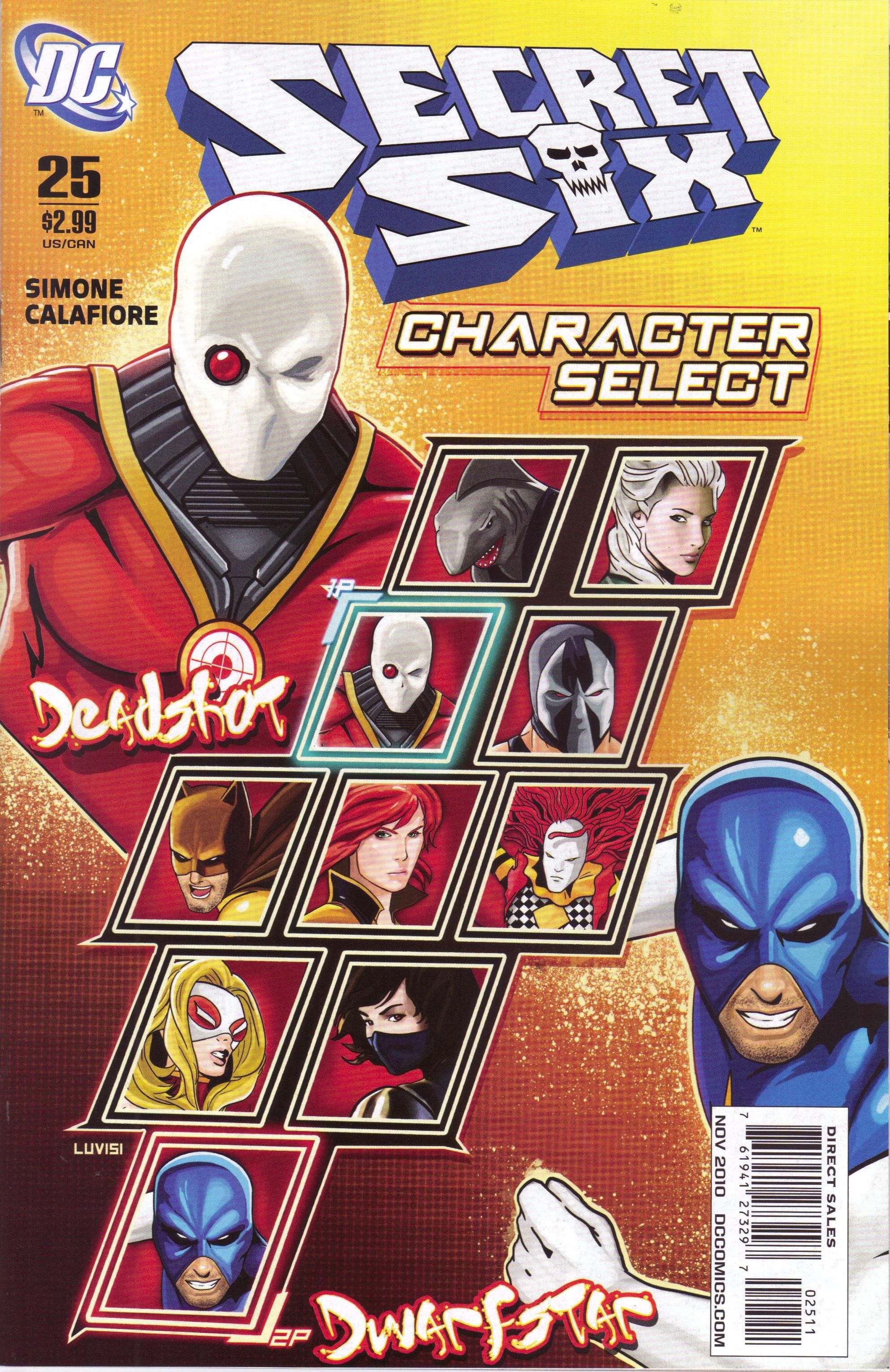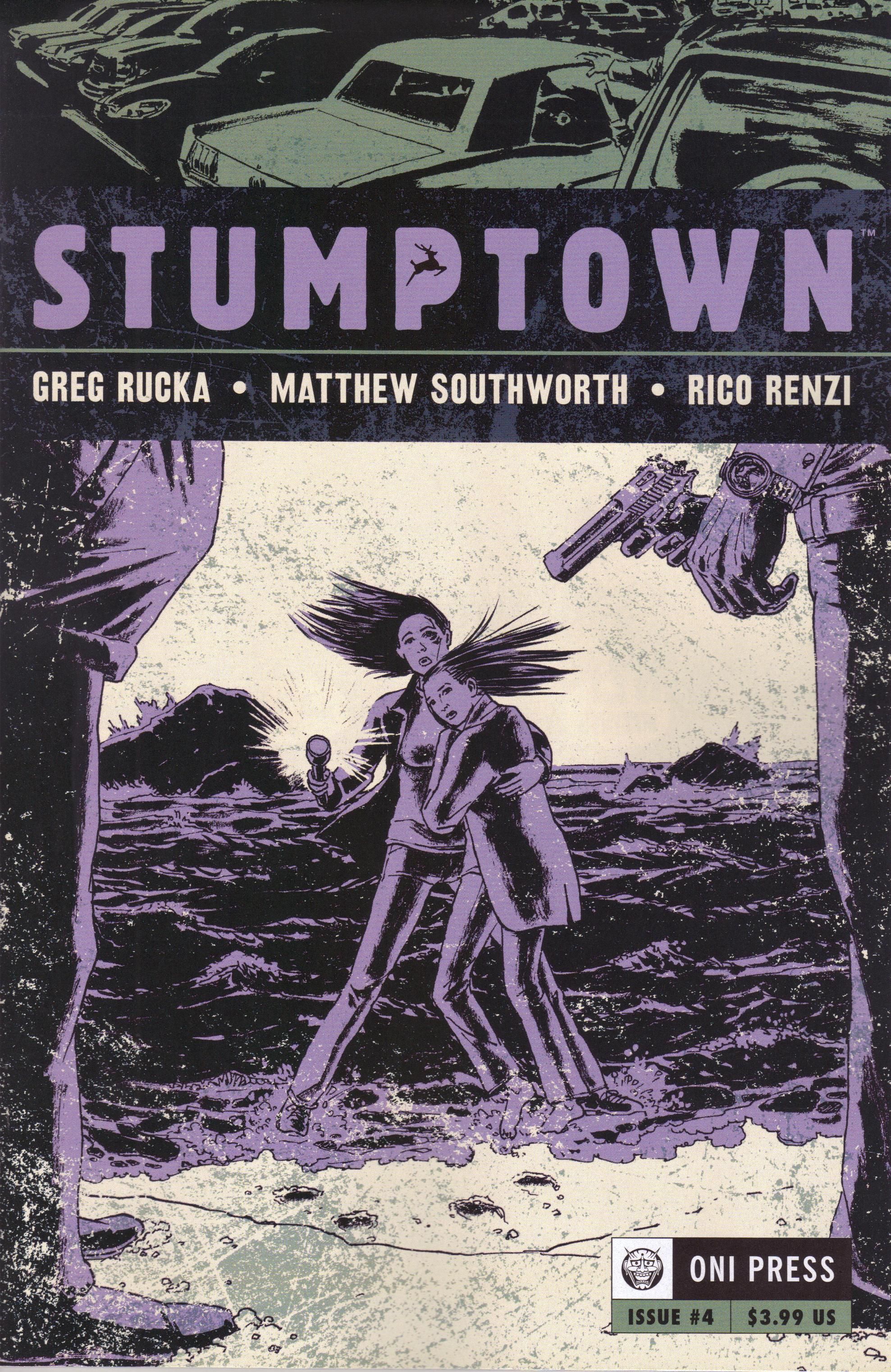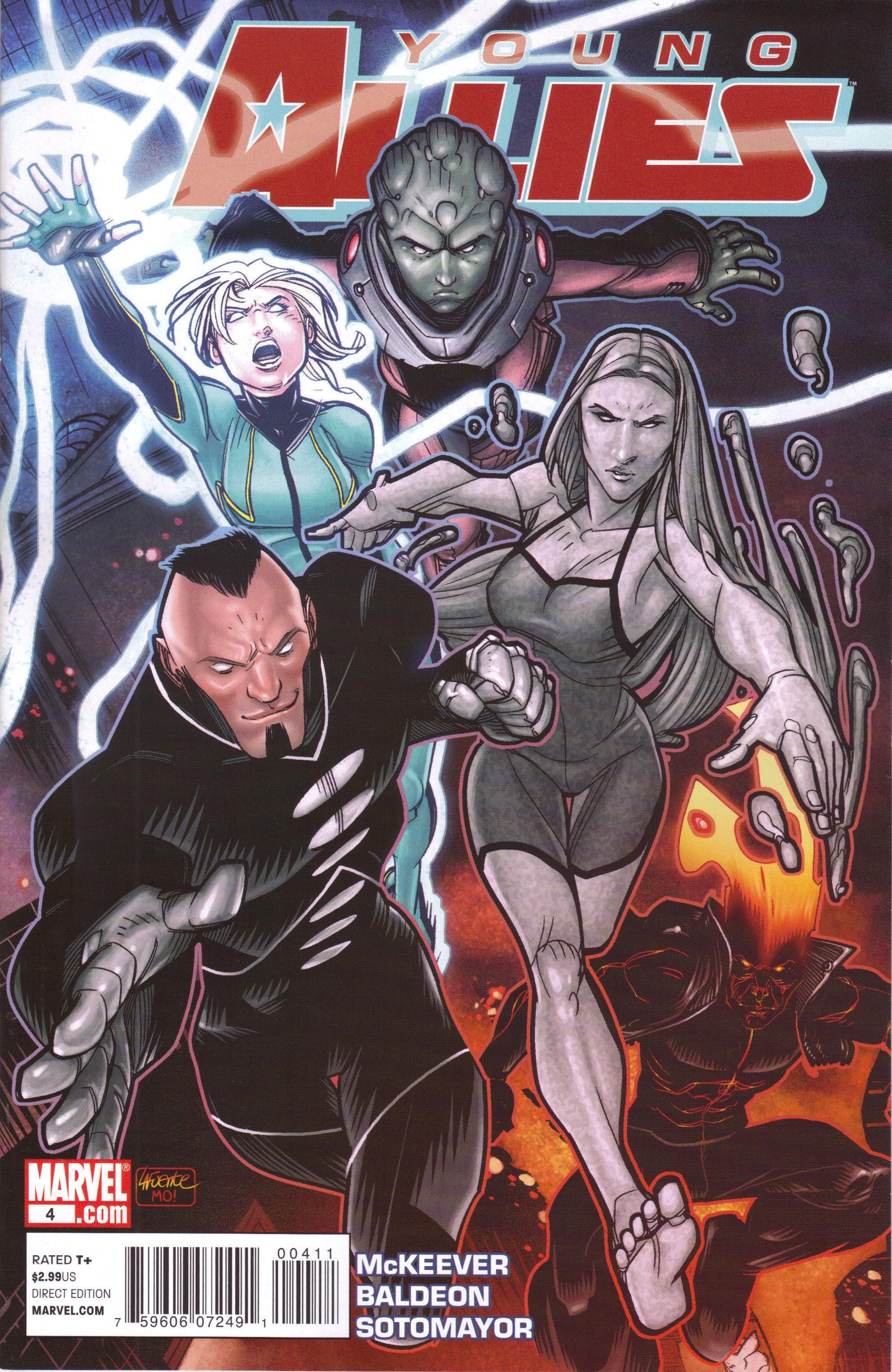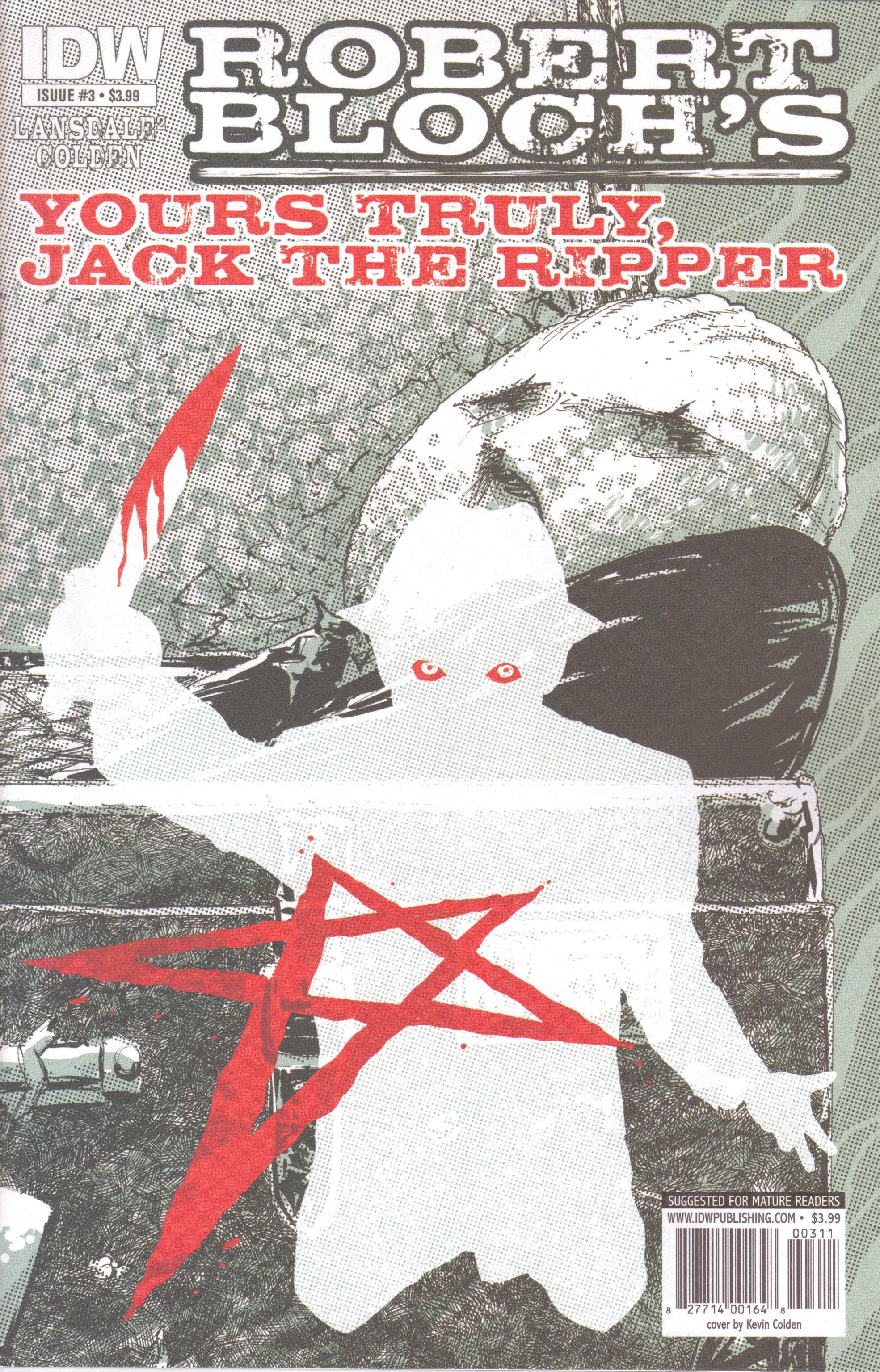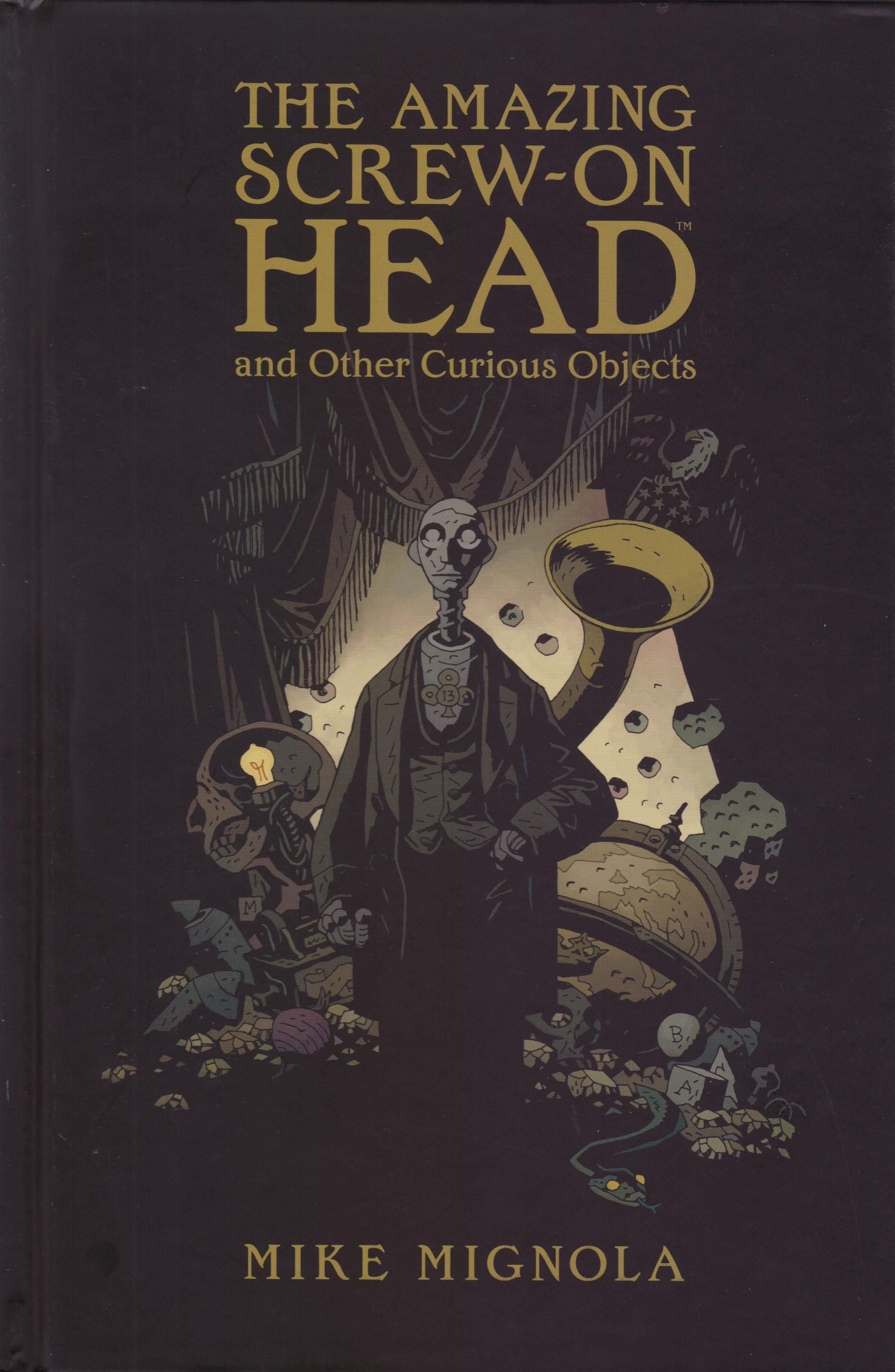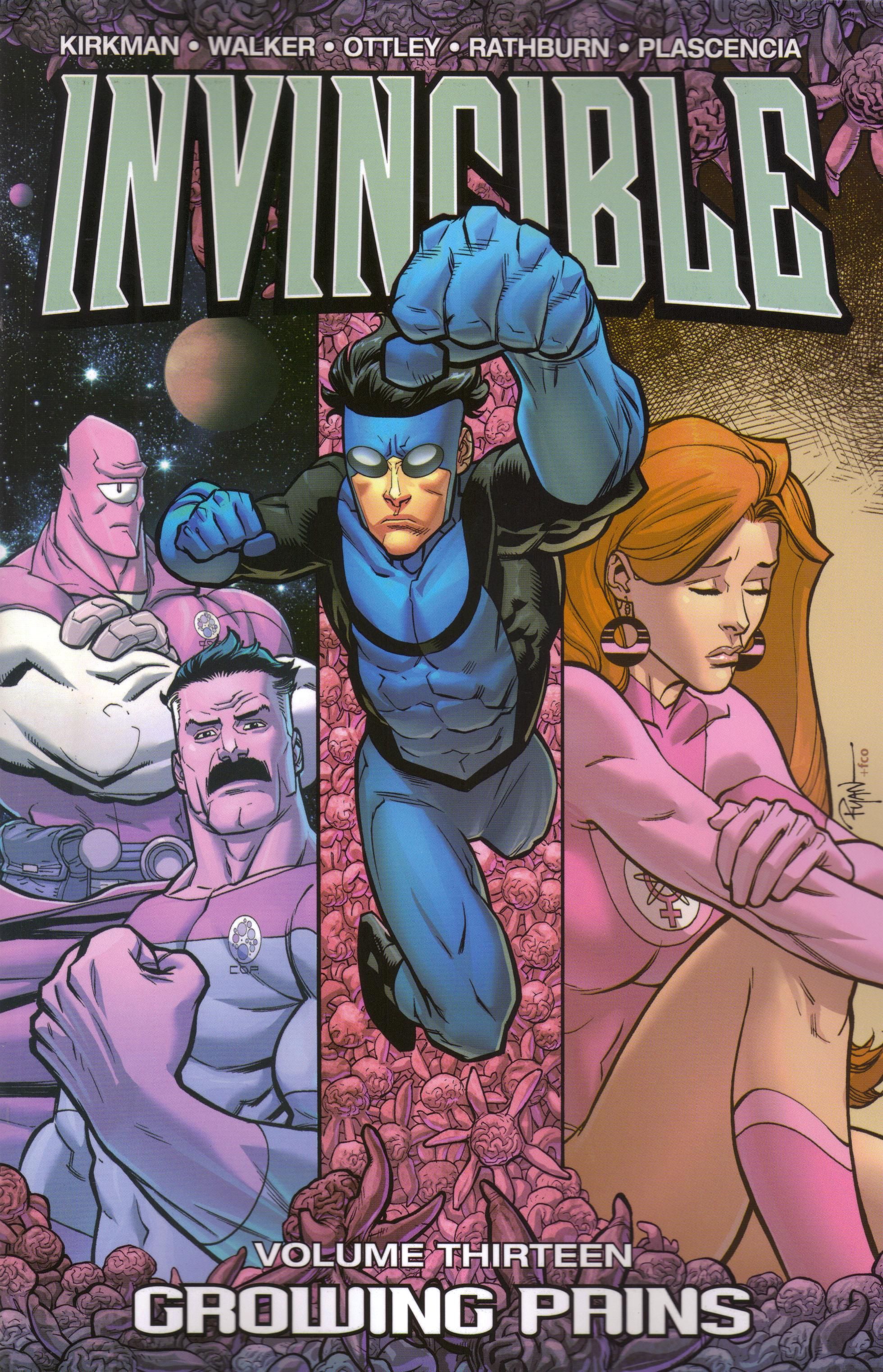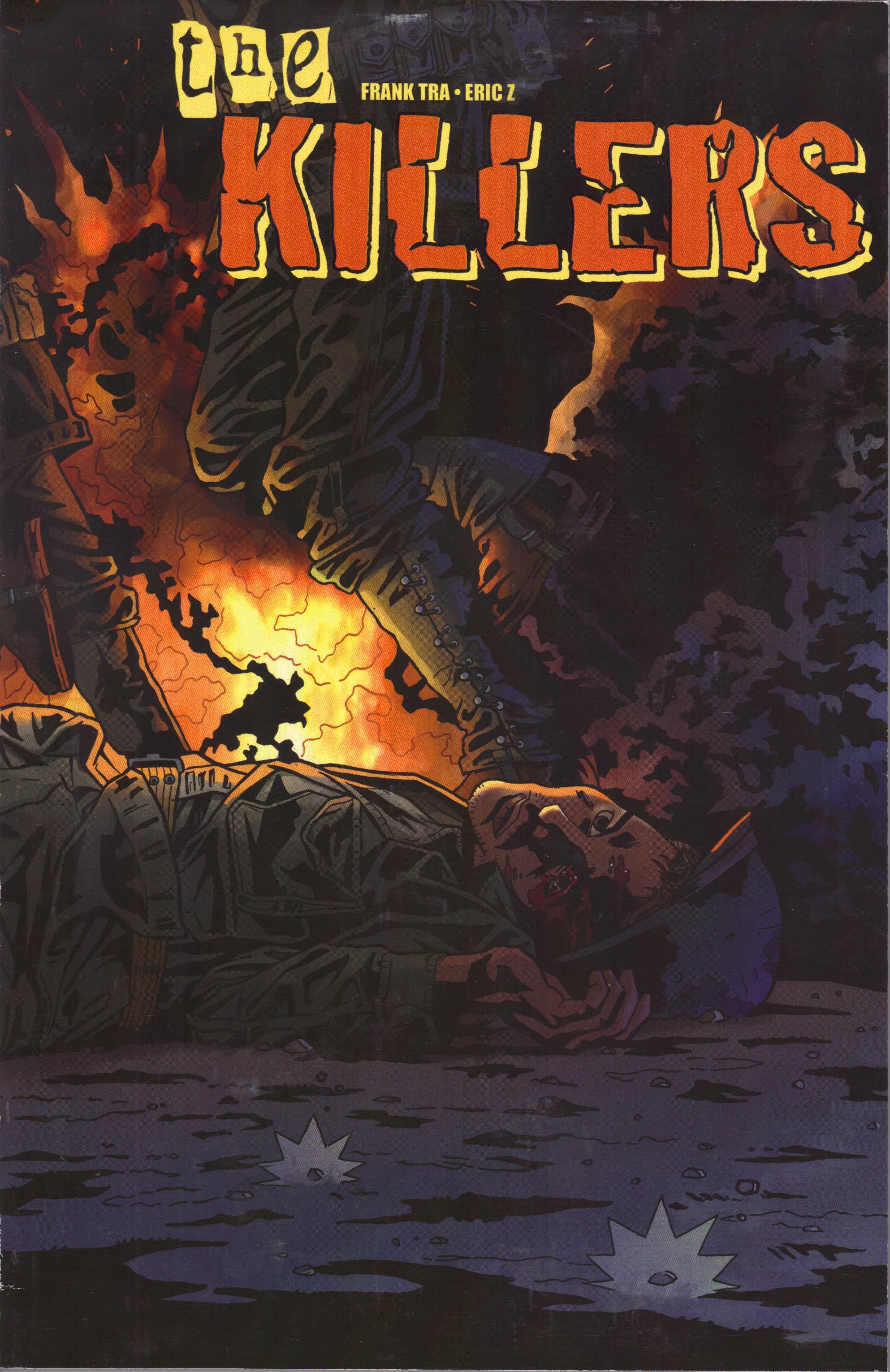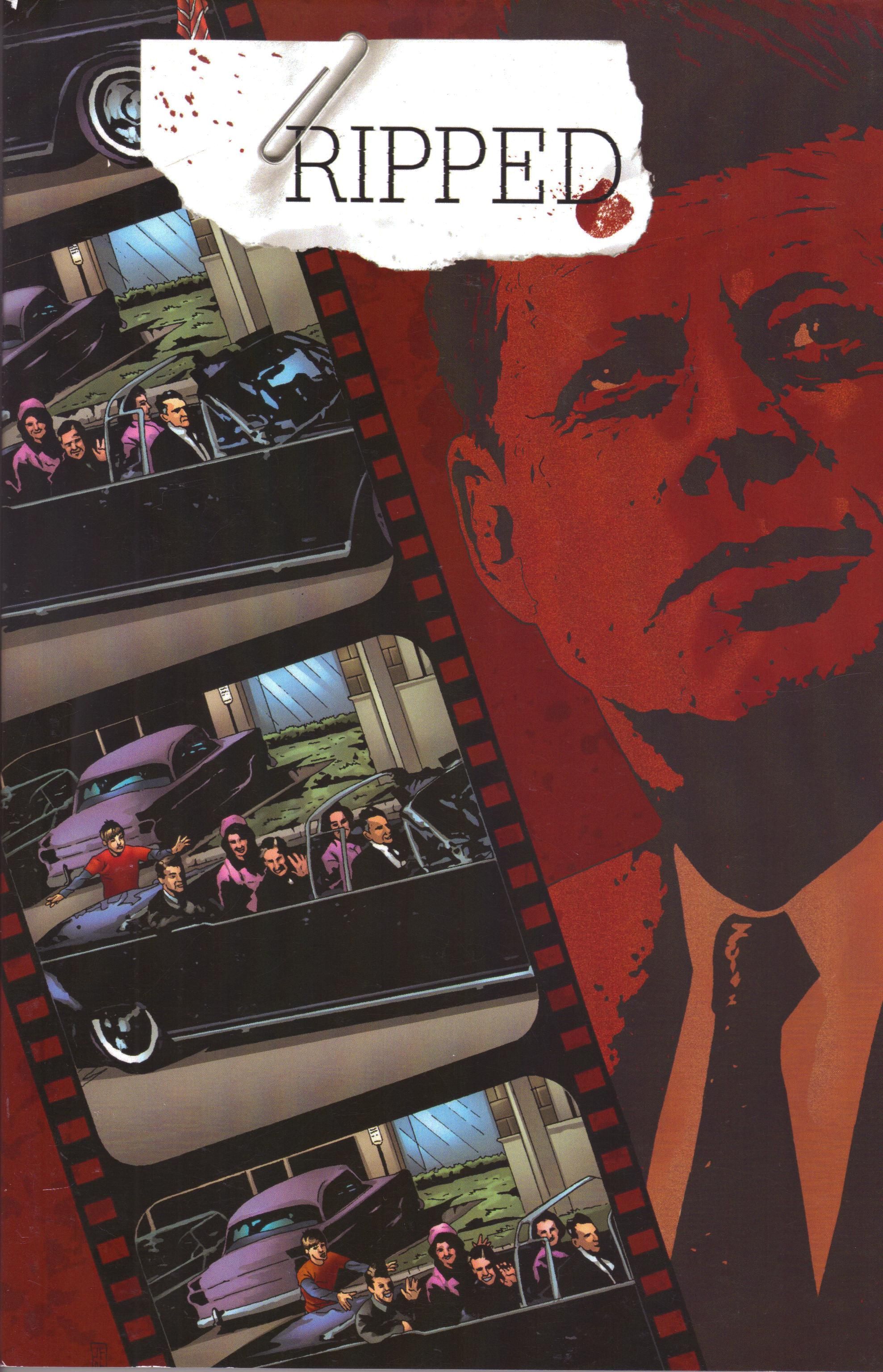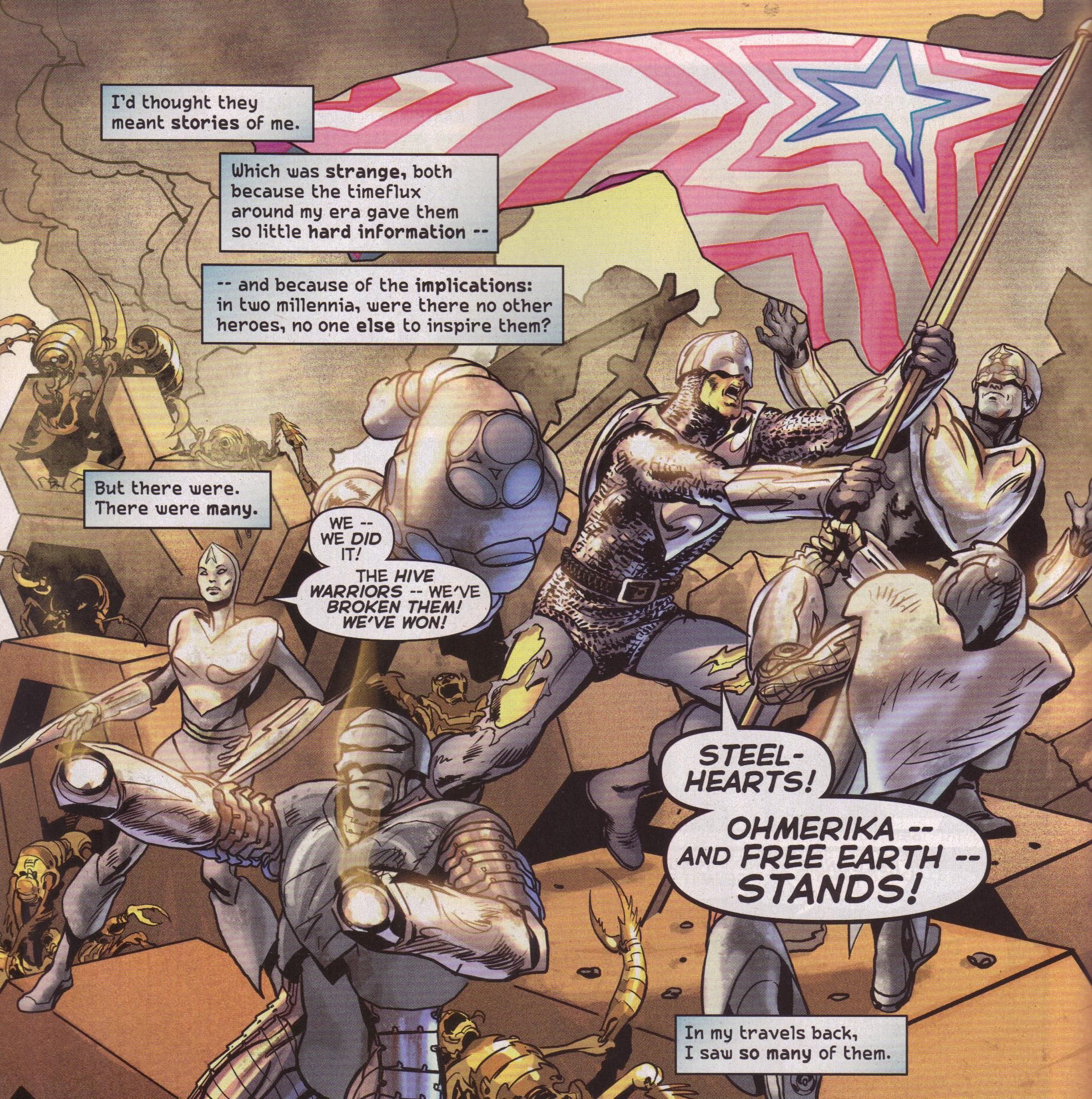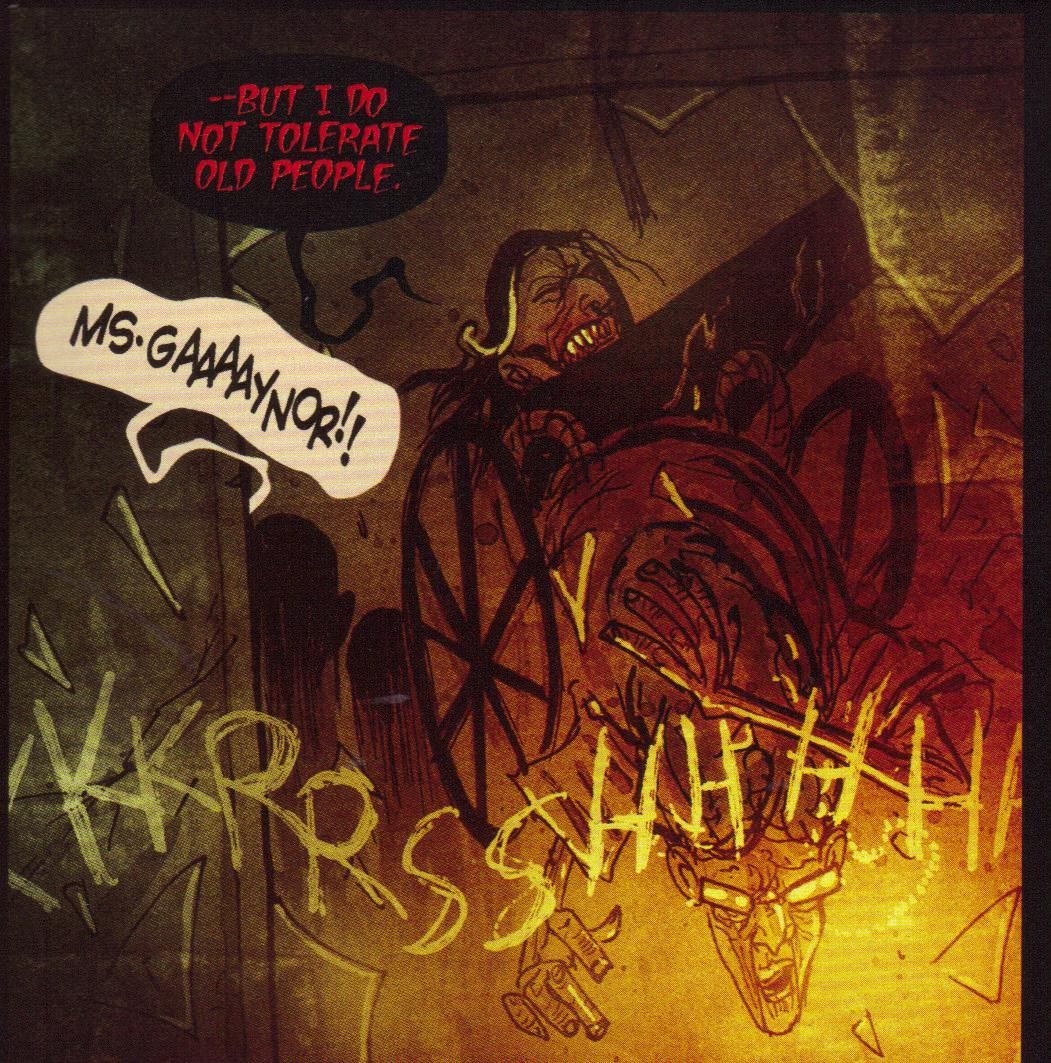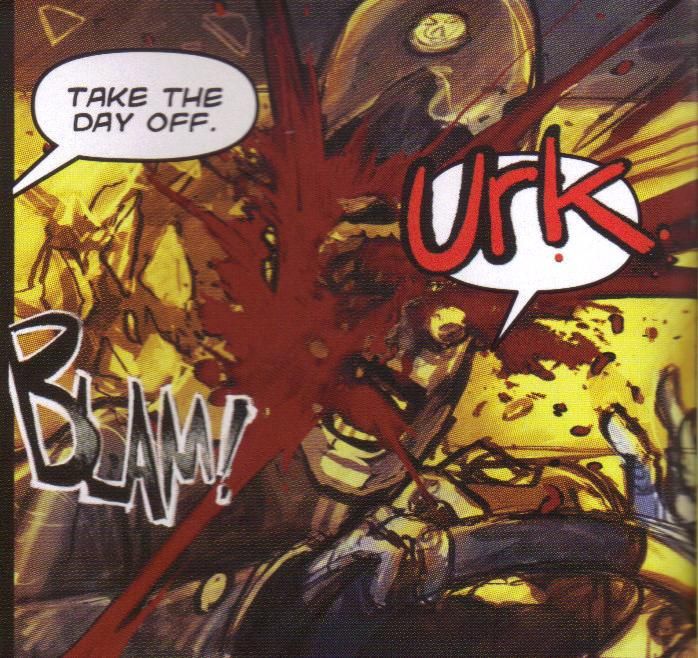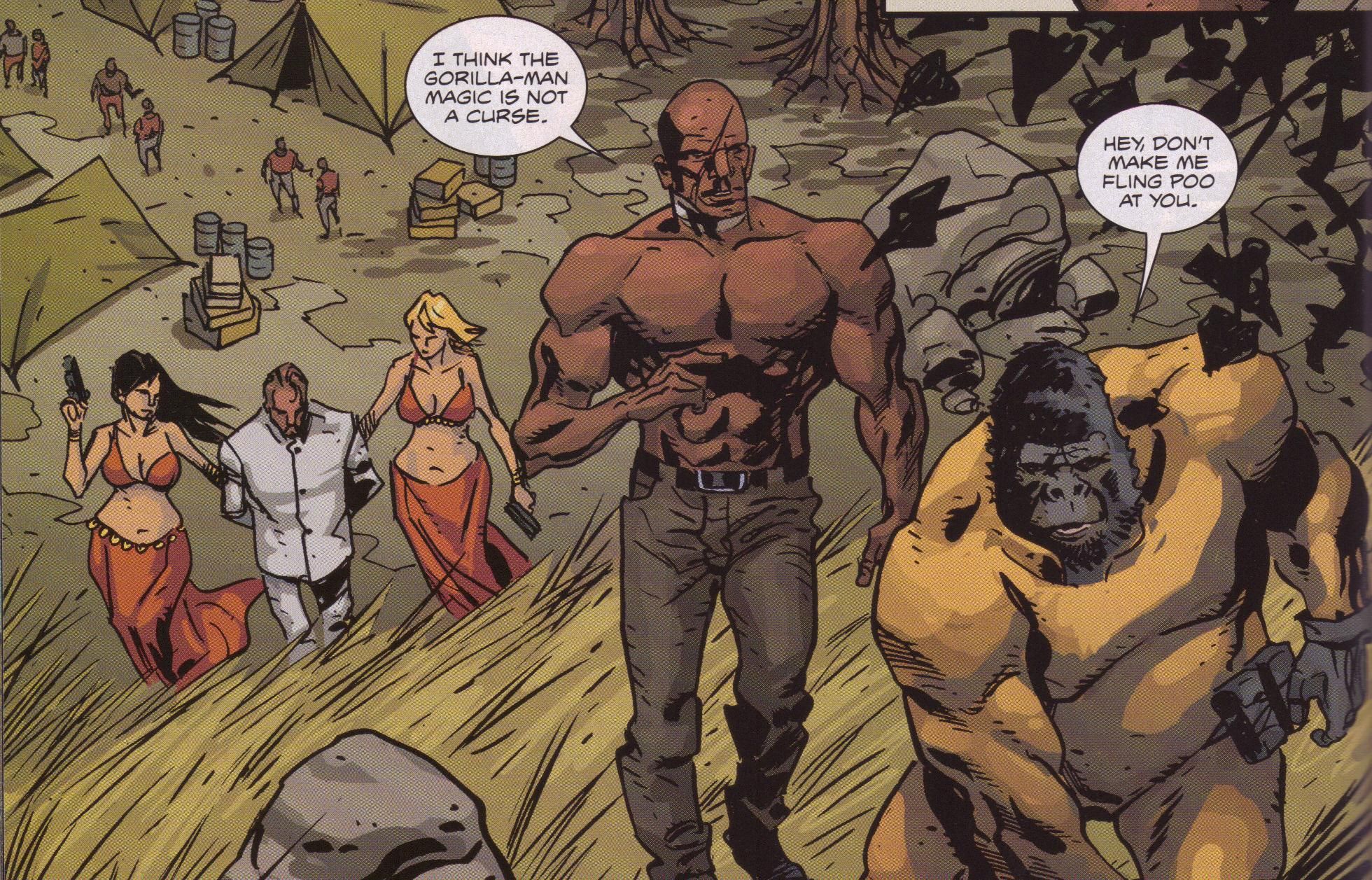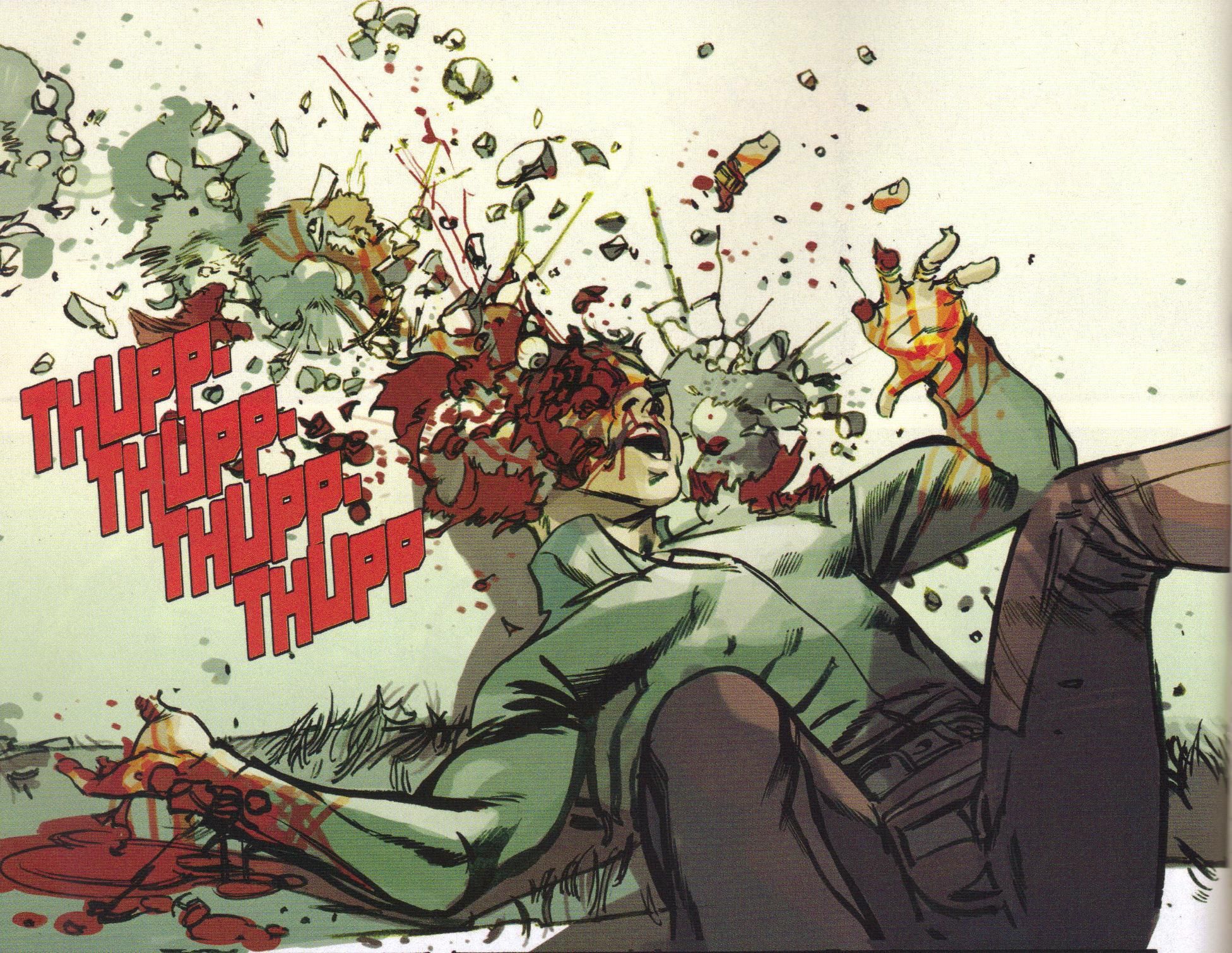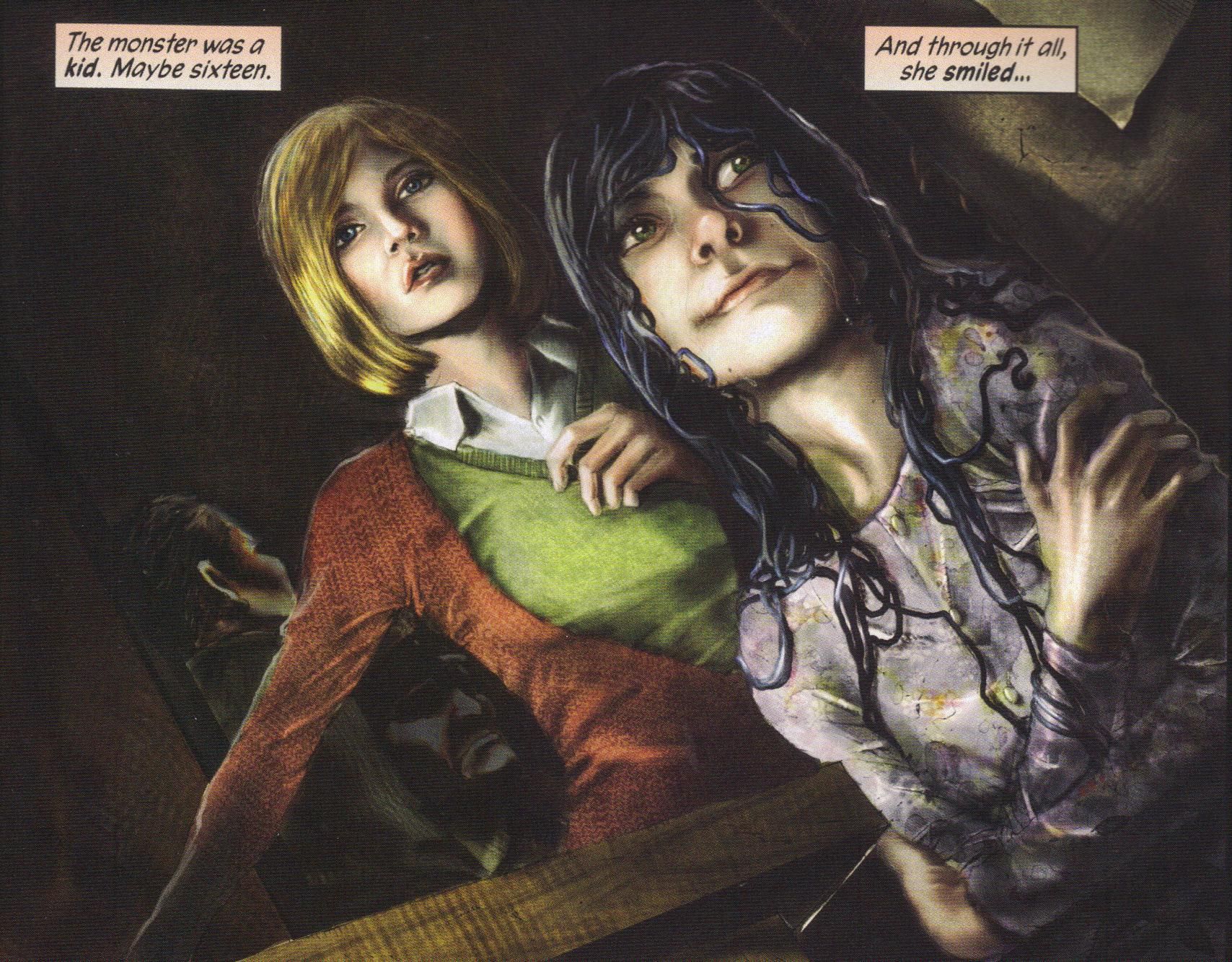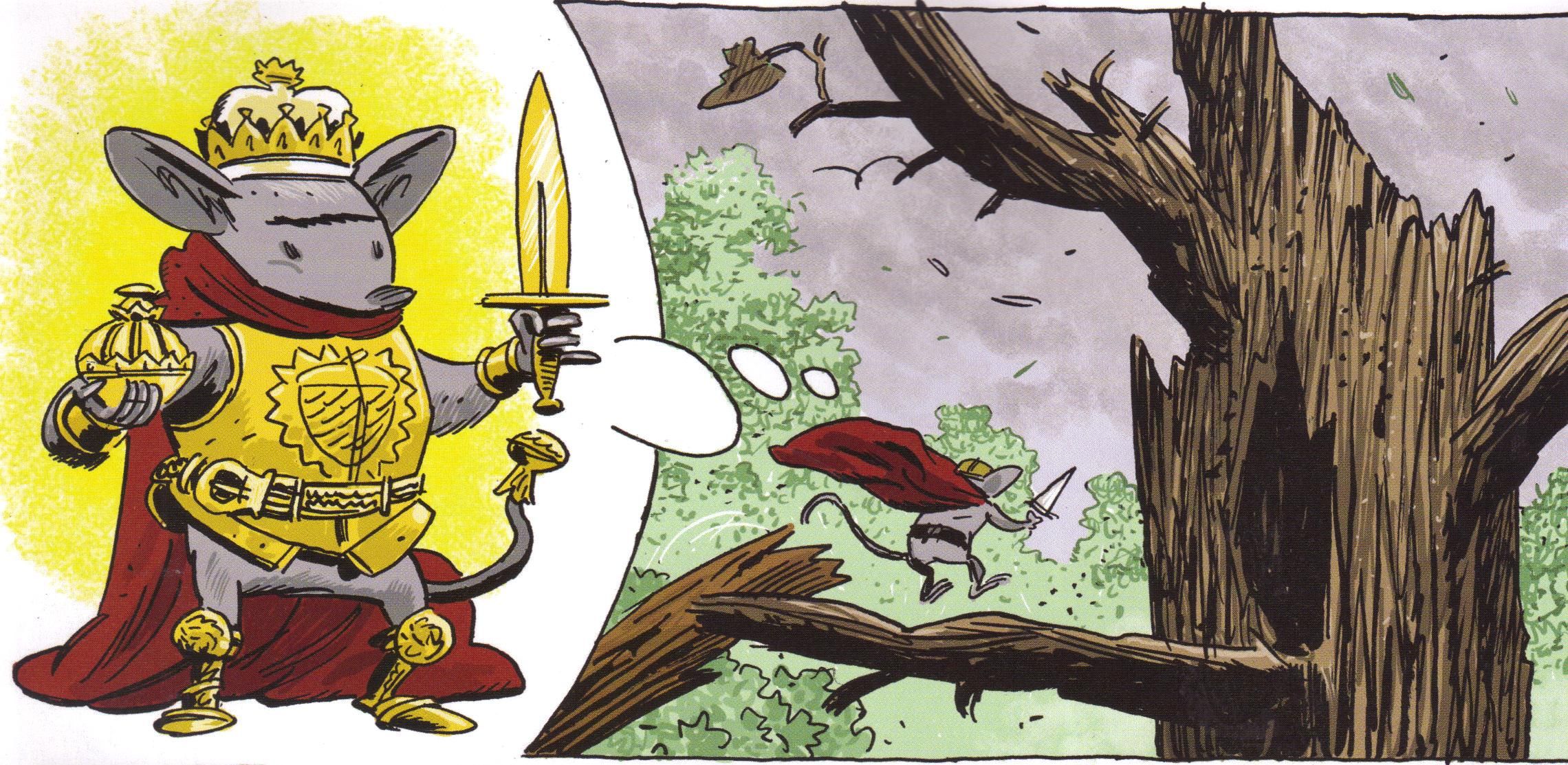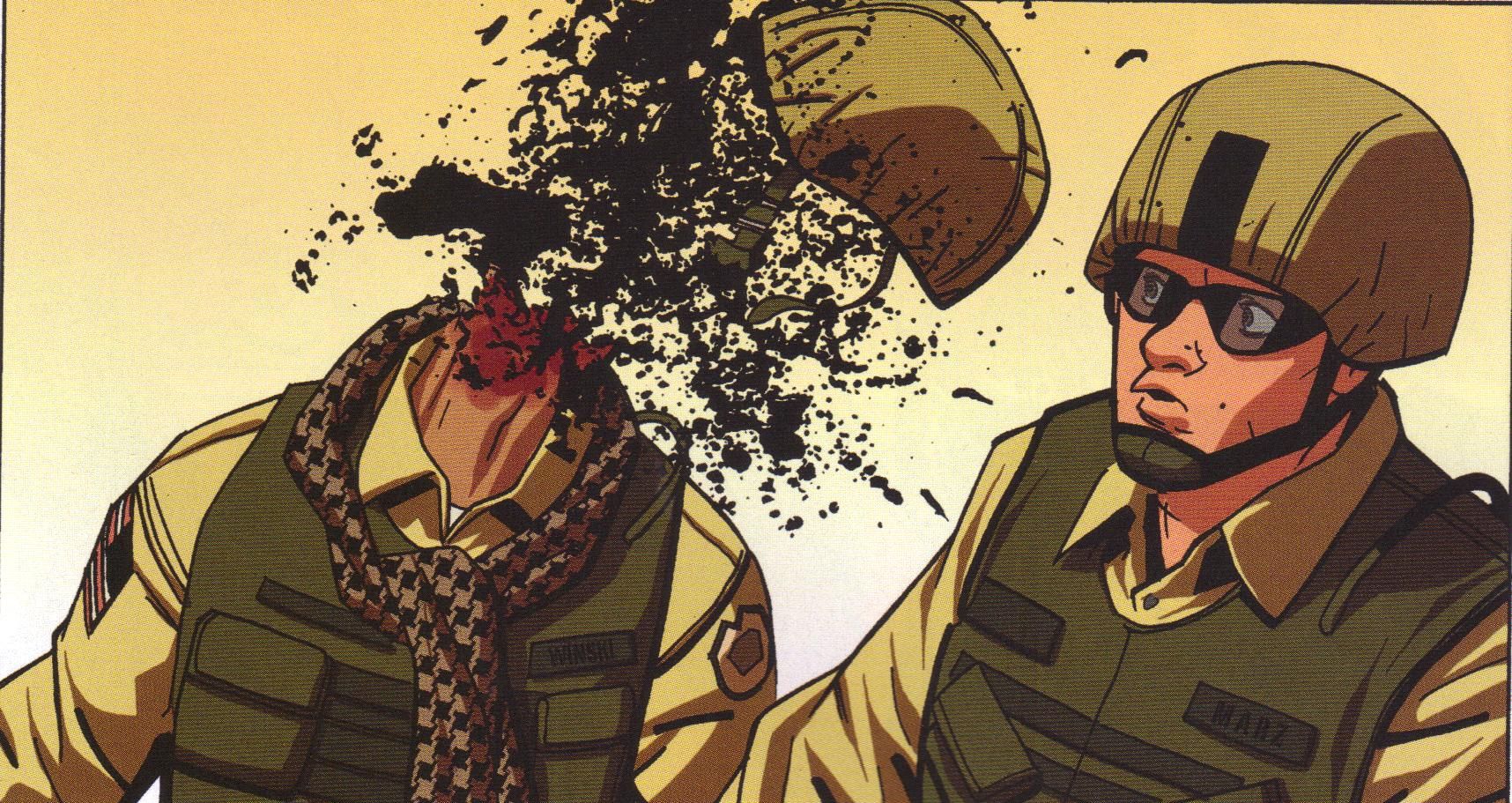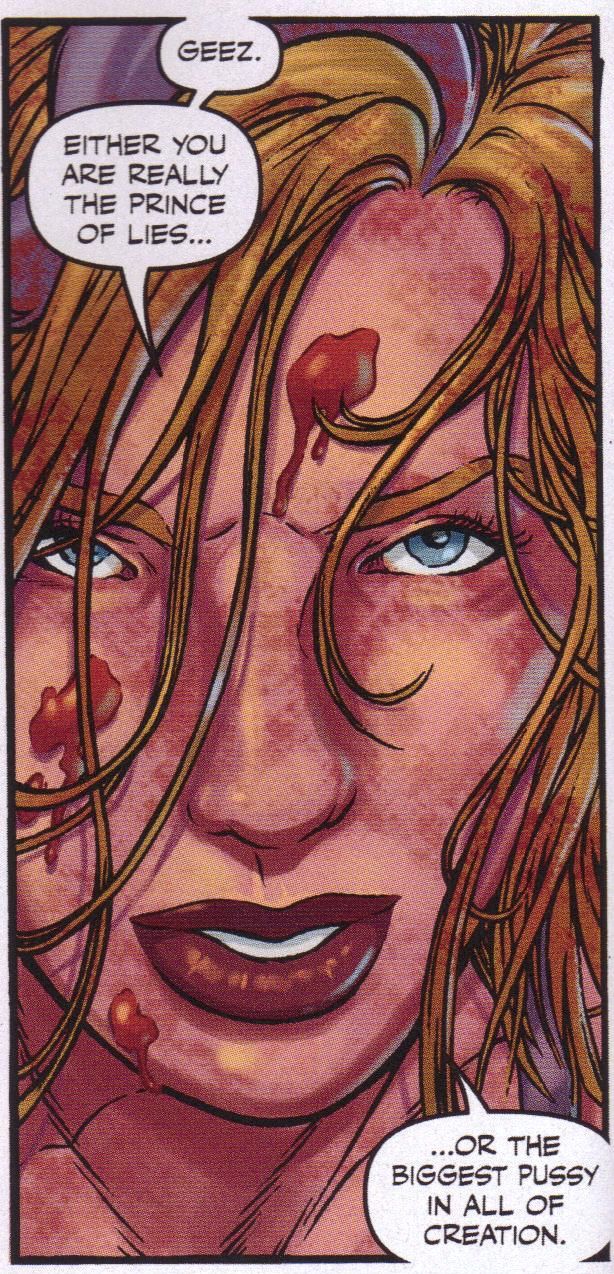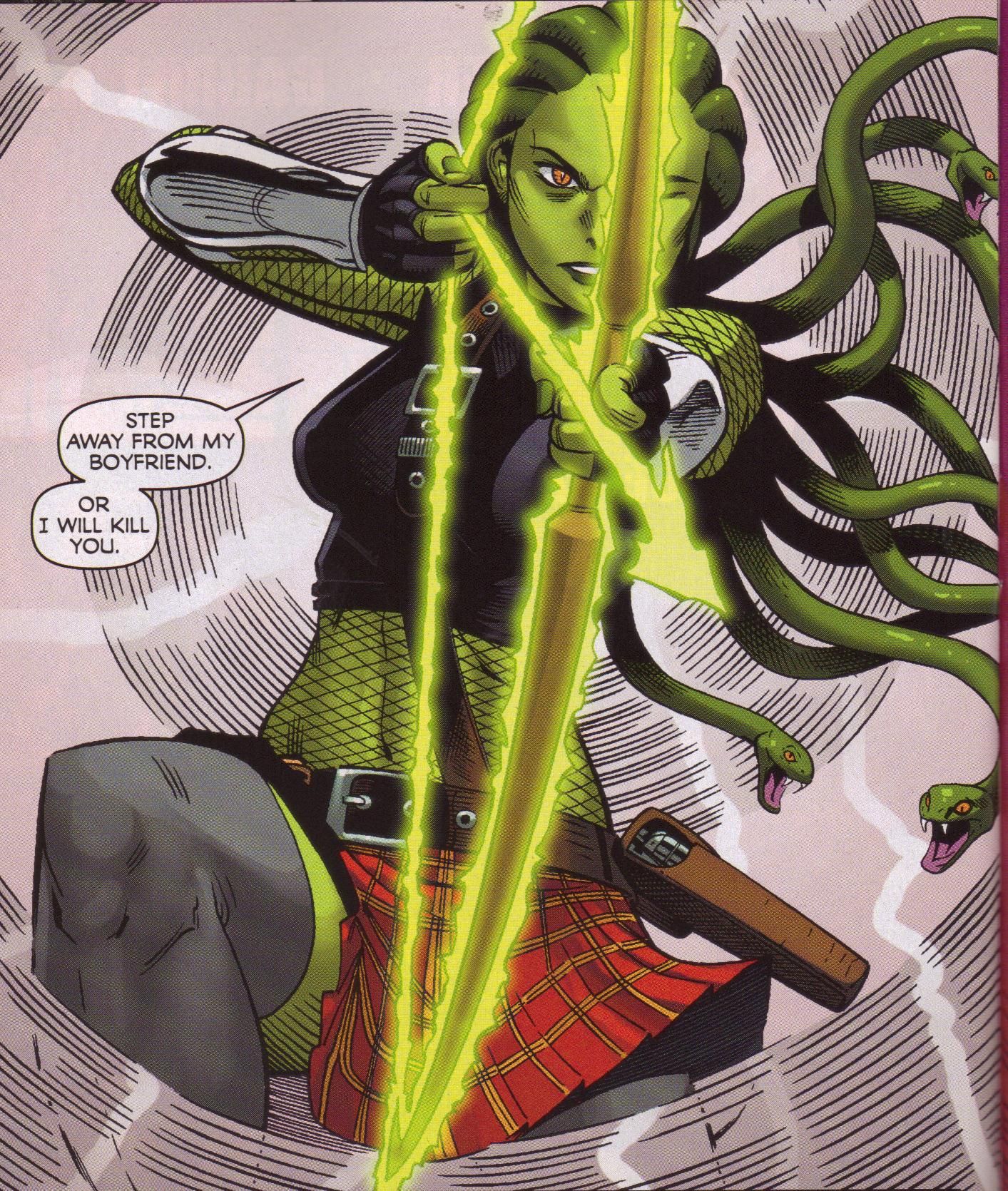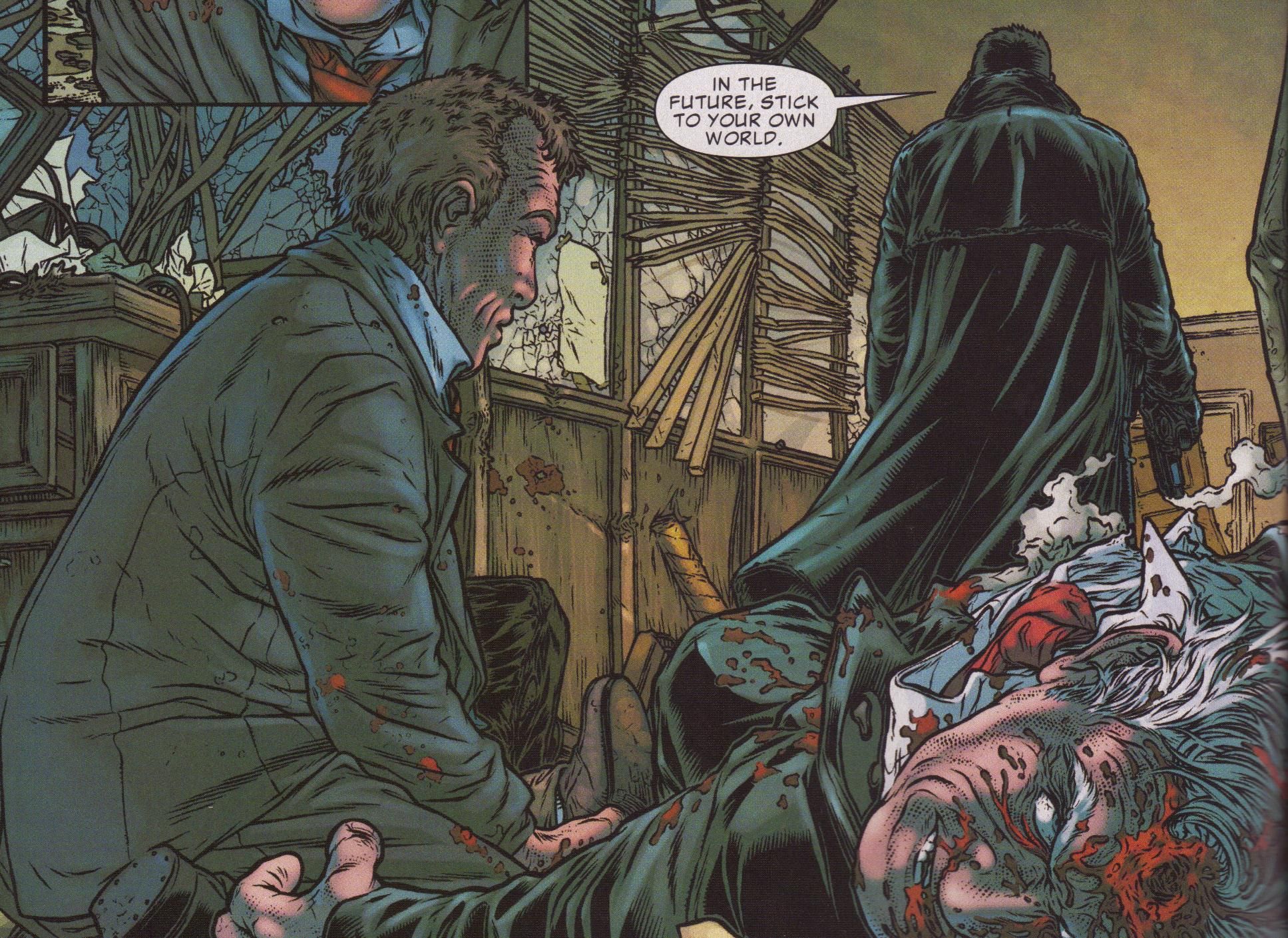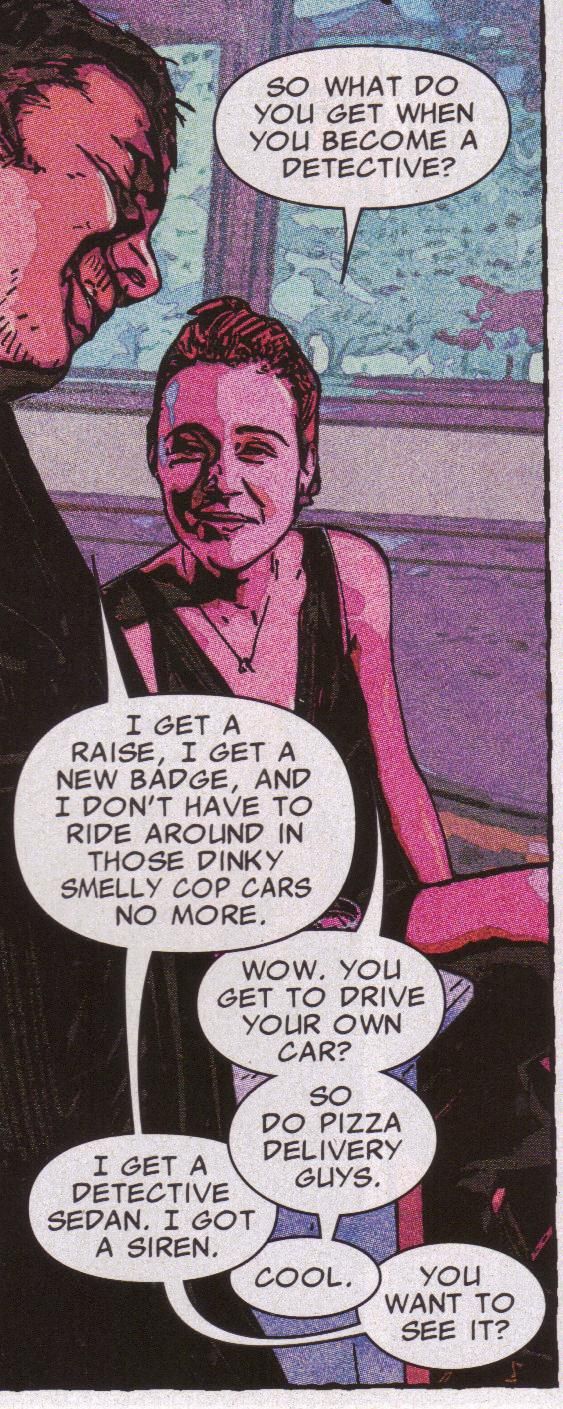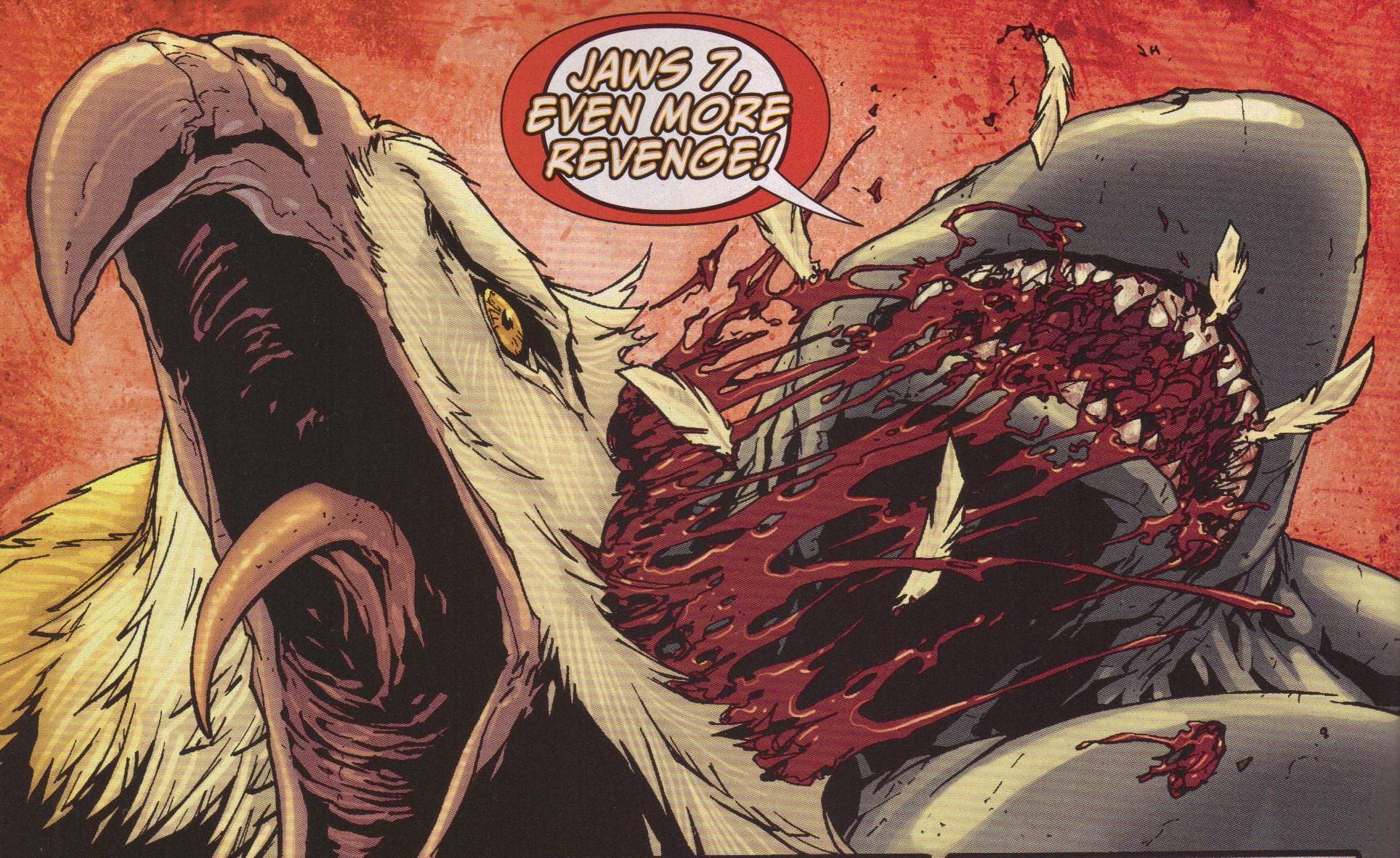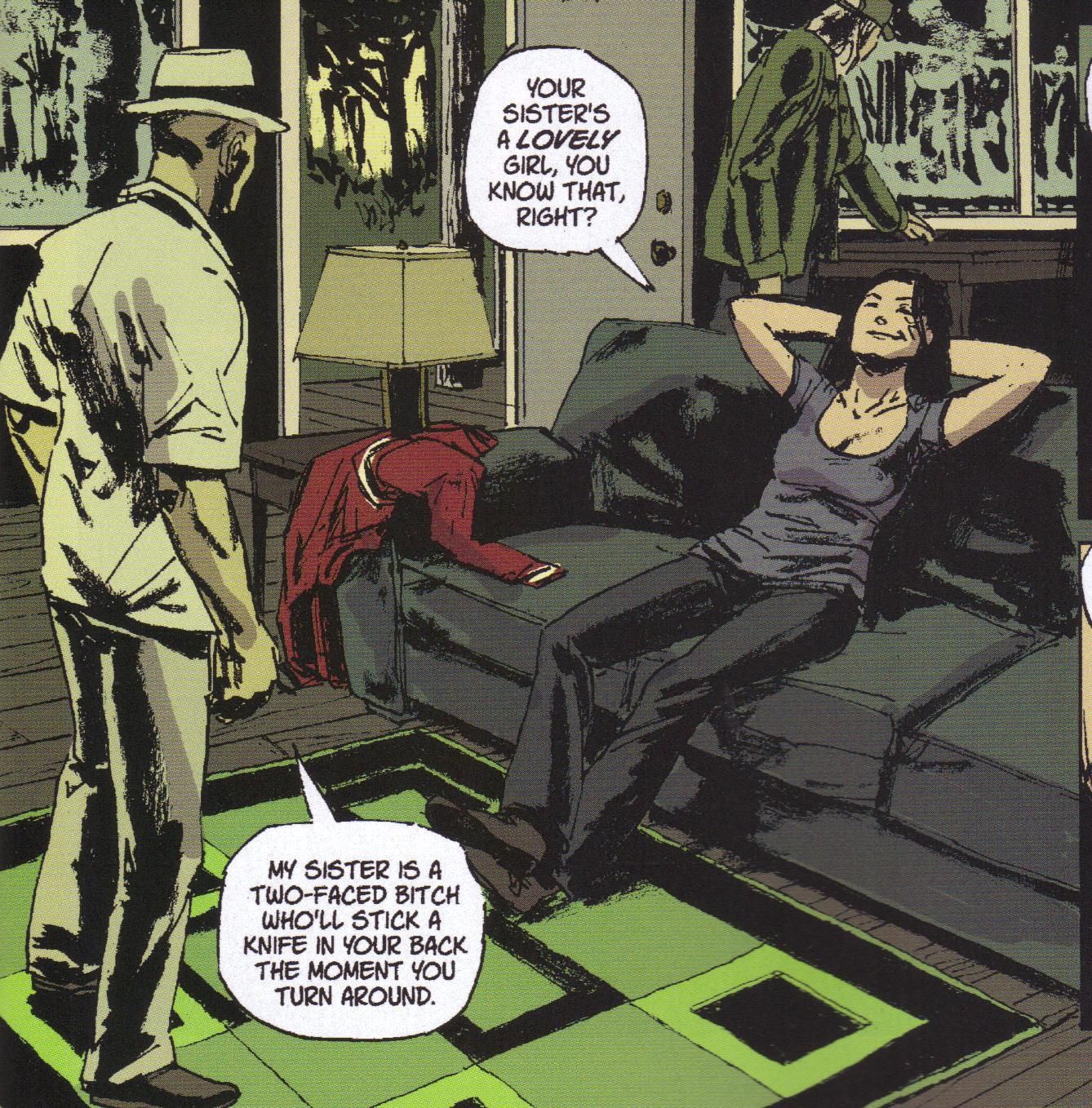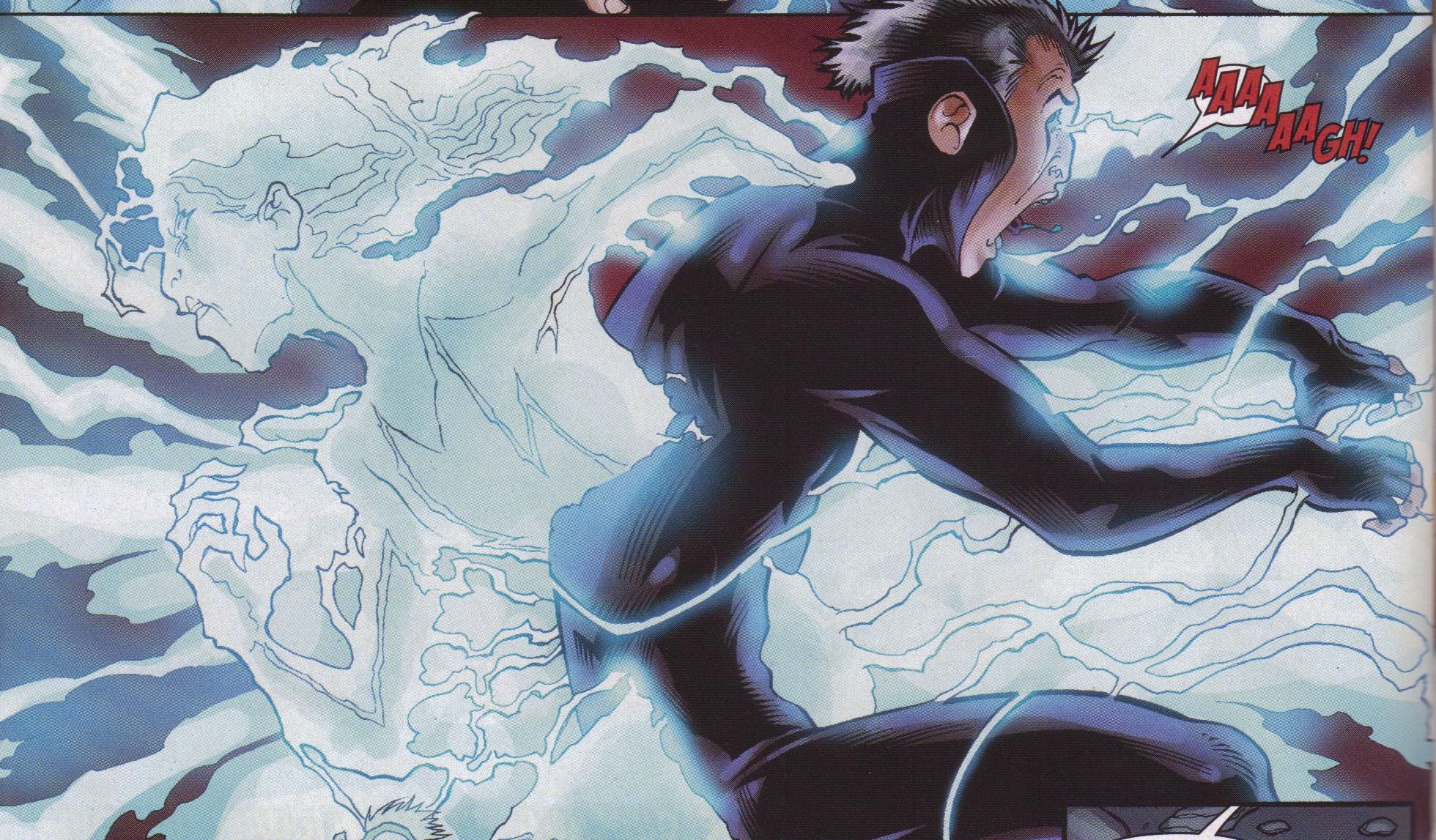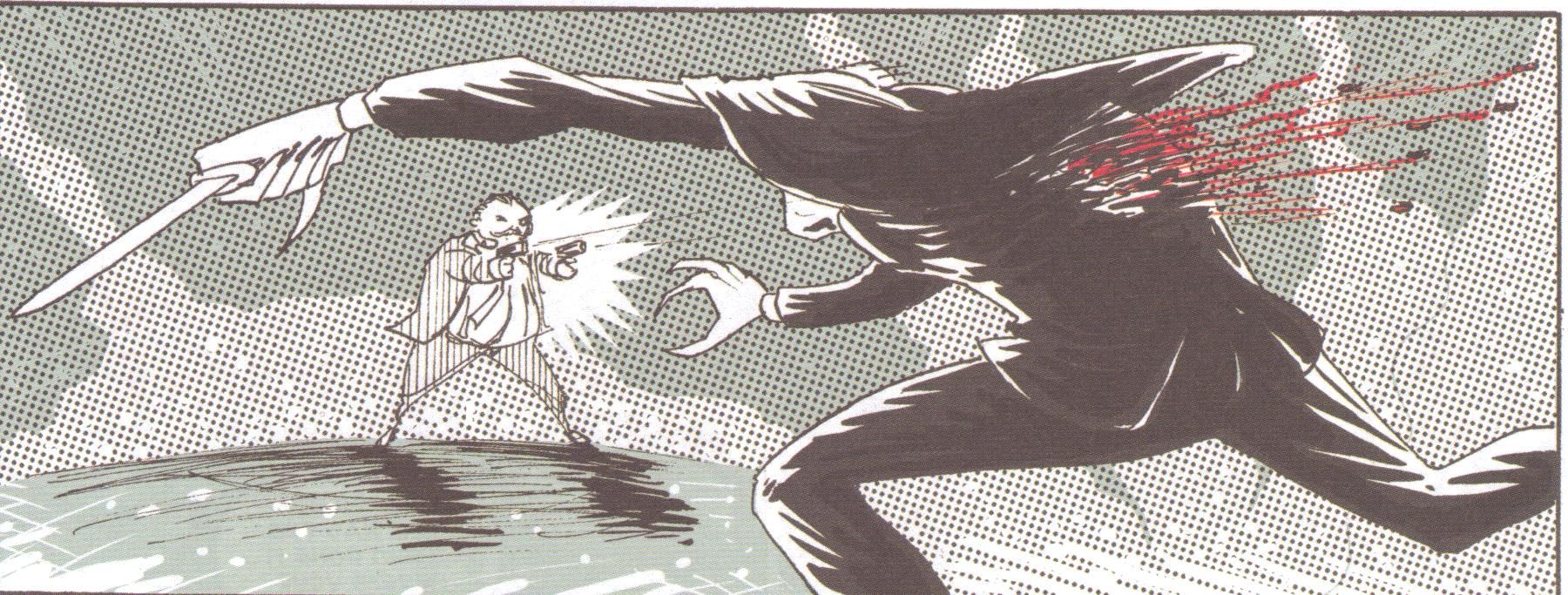"Your profession?"
"Poet."
"Poet? But what do you really do?"
"I write poetry." (Jerzy Kosinski, from Blind Date)
I bought 15 single issues this week and received two for free. One was a preview book, but of the other 16, only 4 (FOUR!) were the standard $2.99 price. Now, I'm definitely not the one to complain about prices, because I buy so many comics anyway, but that's still a bit skewed. So, in honor of that, I'm bringing back the pennies per page index, where I determine how much you're paying per page. Let's see if those comics priced higher than $2.99 are at least worth it in terms of page count!
Astro City Special: Silver Agent #2 (of 2) ("Home to the Hill") by Kurt Busiek (writer), Brent Anderson (artist), John Roshell (letterer), Jimmy Betancourt (letterer), and Alex Sinclair (colorist). $3.99, 24 pgs, FC, DC/Wildstorm.
Busiek wraps up the Silver Agent story before Astro City relaunches as a monthly, and not unlike last issue, it's a weaker entry in the series. That's not to say it's not a good comic, but as I pointed out about issue #1, when Busiek concentrates on the "superheroes doing superheroic things" instead of "man on the street reacting to superheroes and perhaps doing some superheroic things in conjunction with that," the book is a bit weaker because it becomes a normal superhero book. There's nothing wrong with telling the story of the Silver Agent, and Busiek does a nice job with all the time jumping and gives us a pretty cool ending, but it feels less special than most of Astro City. There's a lot of cool stuff in here, like what happens when the Silver Agent finally returns to prison to face his fate and his chats with his nephew across time, but it's still a weaker issue. If the entire story had been told from his nephew's point of view (probably impossible, I know), it might have been a stronger issue, because it would have gone back to the strength of the series, which is how the normal folk react to supers. But that's not what Busiek wanted to do, so I guess that's the way it is!
I will say that I enjoy these kinds of stories that fill in some of the mysteries the series has brought up in the past, but mainly because when I sit down and re-read the series, it will be fun to follow along. In that regard, this is a good story. I have re-read parts of this series and plan to do so again (depending on when I get the time), so I'm sure I'll appreciate it much more when I read it as part of a whole. As a discrete story, however, it doesn't work as well as some of the other arcs. Oh well. Moving on!
PPP (Pennies per Page): 16.625¢
One totally Airwolf panel:
Bullet to the Head #3 (of 6) by Matz (writer), Colin Wilson (artist/letterer), Chris Blythe (colorist), and Chris Caniano (letterer). $3.99, 27 pgs, FC, Dynamite Entertainment.
I really hate that this has such a Pulp Fiction vibe, because it's a fun read on its own, but it feels like Matz wrote it after seeing that movie for the first time and getting inspired. I still like his crisp and often funny dialogue (which is less reliant on cursing than Tarantino's and Avery's) and the story is different from Pulp Fiction and, to be honest, a bit more interesting (Fiction's actual stories felt fairly inconsequential, even Uma's overdose), but we still get the banter, the sudden violence, and the surprising death of a neat character, and the fact that everyone is in a moral gray area but we can't help liking them seals the deal. It's frustrating, because we've seen this kind of thing before and since Pulp Fiction, but that was such an influential movie that I can't get away from it.
Anyway, I still like this comic a lot. Things keep moving forward, as we learn more about the plot to kill the senator and we meet new players in the drama. Wilson's wonderful art remains a big draw, as Matz turns him loose on a few wordless pages that work very well and also relies on him to add nuance to the nice dialogue in some of the more wordy scenes. And, of course, the entire panel is full of details of place - if I might stereotype for a bit, it seems like non-American artists (especially European ones) fill their panels with a lot more than American ones. Perhaps it's because the comics get published as larger volumes, so they don't have to deal with the grind on monthly stuff. Perhaps I'm talking out of my ass. But New Orleans and the other locations in this comic are fully realized, and it adds a great deal to the book. It's not some vague city and some vague neighborhood, in other words.
So this continues to be an enjoyable book. Isn't that all that matters?
PPP: 14.777 ...¢
One totally Airwolf panel:
Choker #4 (of 6) ("Beast Cops") by Ben McCool (writer), Ben Templesmith (artist), and Tom B. Long (letterer). $3.99, 22 pgs, FC, Image.
We get a nice recap on this inside cover, which is good because of this comic's tardiness. It's still difficult to review it, because as always with mini-series, you've either committed to it and are simply seeing how the story shakes out or you're waiting for the trade and don't care how the fourth chapter works, specifically, as long as the entire thing works. So we get some more answers, including what's making all the goth kids go wonky, Hunt Cassidy cracks jokes and rampages, and Jackson's secret shame (the whole crazy arm thing) is exposed at a bad time. There's a puzzling scene near the end, where Walker and Jackson are drinking in a bar and Walker sees someone who appears to be Cassidy, and she just leaves Jackson alone to chase after him. It's not explained, either. Is it Cassidy? Is it someone else who's important to Walker? I have a feeling it's not Cassidy but her brother or cousin or ex-boyfriend and she didn't know that he had turned into a weird vampire thingy, but it's very unclear. Given that it might be six months before issue #5 comes out, it's kind of annoying.
But let's hope it's sooner than that!
PPP: 18.13636 ...¢
One totally Airwolf panel:
Critical Millennium: The Dark Frontier #2 (of 4) by Andrew E. C. Gaska (writer), Daniel Dussault (artist), and Nina L. Kester (letterer). $3.95, 36 pgs, FC, Archaia.
Gaska gives us some more details about the project to colonize distant planets, as Thomm and Eryc meet a foxy doctor, Pandita (we don't know if that's her first name or last name) and Thomm hooks up with Angel Rei, a pop star, and they continue to try to convince humanity that they need to leave Earth and find new worlds. Meanwhile, the white people down on Earth are still plotting to take the planet back from the Indian and Chinese leaders. We get quite a bit more plot than we got in issue #1, and Gaska's writing, while not great, gets us through the story nicely. Dussault's art has a bigger manga vibe in this issue than in issue #1, and his colors are a bit sloppier. The art is still good, but it's not quite as crisp and dynamic as it was in issue #1. I don't know if he rushed it or not - the book is a bit late (I think it was supposed to be monthly, and it's not quite) but not ridiculously so, and given Archaia's track record in not getting books out on time, delaying this doesn't seem to be that big an issue. Dussault still does a nice job with the future world, making sure it's different but familiar, and some of his scenes, like the test flight of the spaceship that will propel Thomm and Eryc out of the solar system and the flood in New Bombay (why not Mumbai?) work very well. Pandita and Angel look far too similar, though, and while I doubt if it will become a problem because they're so different in personality, it's still annoying.
This is turning into a pretty good book, and I always like ambitious comics. I do hope the art doesn't deteriorate any further - take your time, gentlemen!
PPP: 10.97222 ...¢
One totally Airwolf panel:
Gorilla-Man #3 (of 3) ("The Serpent and the Hawk Part Three") by Jeff Parker (writer), Giancarlo Caracuzzo (artist), Jim Charalampidis (colorist), and Ed Dukeshire (letterer). $3.99, 22 pgs + 7-pg reprint (by some dudes named Lee, Lieber, and Kirby), FC, Marvel.
There's not really much to write about this mini-series. Parker can write, Caracuzzo can draw, and together they give us an entertaining story that blends Ken's origin with a rousing adventure. Parker's nifty sense of humor comes through (see below, plus when Ken has to leave the gorillas because of all the naked females), and everything gets tied into Jimmy Woo and his organization. I can't really write much more about it. Get the trade, which will presumably have some extra stuff, shelve it with all your other Atlas-related trades, and enjoy reading Parker's grand espionage/adventure tale when it's all collected. Given the fact that he still has the negatives of Joey Q and that Thai she-male, I expect we'll see another story about these characters in the future. Enjoy them while you can!
PPP: 13.759¢ (If you count the reprint, and I did)
One totally Airwolf panel:
The Last Days of American Crime #3 (of 3) by Rick Remender (writer), Greg Tocchini (artist), and Rus Wooton (letterer). $4.99, 52 pgs, FC, Radical Comics.
I don't know how much momentum this series has lost because of the delay of this final issue, but I imagine many people were waiting for the trade anyway, so maybe not much. Radical was nice enough to send this off to me, and I'm glad, because other than Hotwire, this has probably been the most enjoyable book they publish. A great deal of that has been because of Tocchini's art, which is much better on this comic than I've ever seen it, even though there are some ugly, sloppy panels in this book. Many of them come early in the book, and I was worried that the entire book would be ugly, but Tocchini recovers and by the time Graham and his posse are engaged in the heist, everything looks wonderful once again. The violence is visceral and shocking, the characters - even a sex bomb like Shelby - look like real people, and Tocchini does a good job telling the story. It's a busy book, art-wise, but it's never cluttered. Nice to see.
Remender's story is a solid heist story with the requisite twists. There's nothing too surprising here, but it's entertaining, and the double-crosses, while telegraphed, are handled well. Remender always remembers that in heist stories, we might not have to like the characters, but we have to relate to them, and he does that pretty well in this comic, especially with Graham, whose back story is the most fleshed out. Even though Graham is the star of the book, it's nice that Shelby and Kevin get some history too, because it comes into play as the heist goes along. Shelby's attraction to Graham even makes sense as Remender goes through the story. There is some darkness lurking in the characters' history, but Remender leaves a good deal of it to our imagination, which is nice. This is, after all, a heist story, so it can't get too psychological. Remender is quite good at giving his characters depth without delving too far into it. This series is a good example of it.
I'm not sure how much the trade is (I could check, I suppose), but if it's 15 bucks, this is a good value. It's an entertaining and exciting story with very good art. The basic premise (that the United States is going to brainwash everyone so they don't commit crimes) might be goofy, but if you ignore that, it's a fun read!
PPP: 9.596¢
One totally Airwolf panel:
Mata Hari #0 by Rich Wilkes (writer), Roy Allan Martinez (artist), Draženka Kimpel (painter), and Todd Klein (letterer). $1.00, 21 pgs, FC, Radical.
Gianluca Glazer also sent this to me, so I'd like to thank him. This is a preview for a graphic novel that will be released in "spring 2011," according to the back cover. It's a teaser!
This ought to be right up my alley, because it's espionage and it's historical, and I loves me some historical espionagey stuff! And I did enjoy this, although it's not perfect. Martinez is a solid artist, and unlike some of the other Radical illustraters, his art doesn't look digitally composed, or at least not as much as some of their books. He actually has a style, as well, instead of just smoothing out all his rough edges. It helps that he's credited as "illustrater" while Kimpel is the painter - instead of one artist creating this on a computer and coloring it digitally at the same time, I imagine Martinez did this without color and then Kimpel painted it from the roughs. So even if you don't love Martinez's art, at least he has a decent style. He needs to show both a stripper and the front line of World War I, and he has no problems with either.
Wilkes gives us just a sampler of the story, introducing the principal characters - Vadim Maslov and General Robert Nivelle form two parts of a love triangle with Mata Hari, plus we have a girl named Antonia Maslov who has a secret. Wilkes gives us just enough about the characters to entice us, even though he ignores the central figure of the book - Mata Hari appears only when others are talking about her, so we don't get any clear sense of her. But it's just a teaser, so I can forgive it.
The biggest problem with the book is that Wilkes is all over the place with the narration, and if it comes to us in this form in the graphic novel (without any pages in between or explanations about who is narrating), it will be a problem. First of all, he screws up the time frame. The story begins in 1953, and the narrator is a woman named Onya, who was once a police clerk. She interviewed Antonia one night when she was brought into the station carrying a jar holding a severed head. However, Onya claims that she met Antonia "57" years before 1953, but it's clear that it's probably 1916 (or 1917, as this was when Mata Hari was executed), so either Wilkes screwed up how long ago it was or the first caption box should read "1973." Either way, it's vexing. So Antonia tells Onya about Mata Hari. It's very clear about this. "She told me then of a woman more powerful than I could have imagined" begins the long overview section of what we know about Mata Hari. But then Wilkes switches to modern references, such as Madonna and Elvis, and later the narration, which seems to be Onya again, mentions World War II. She also references Tolkien and even Franz Ferdinand, the band. It's really weird. Wilkes also blames the assassination of the Archduke Franz Ferdinand on a "Muslim terrorist group" (drawing a parallel between it and the events of 11 September 2001), but there's very little evidence that the Black Hand, which was the group Gavrilo Princip was associated with when he killed the archduke, was in any way religious - they were Serb nationalists, basically, and didn't have a religious ideology. That's a minor error - the real issue is the way the narration seems to be omniscient and in the present when it keeps shifting back to Onya. It's frustrating.
I don't know if these problems are indicative of the longer work as a whole or if it's somehow explained in the book. If there are pages missing (it doesn't feel like there are), that's one thing. But it takes me right out of the story, because it's as if Wilkes is being deliberately misleading. I think this has a lot of potential, but some of the writing needs to get straightened out before the graphic novel hits the shelves.
PPP: 4.762¢ (Obviously, this is skewed because it's a preview book)
One totally Airwolf panel:
Mouse Guard: Legends of the Guard #3 (of 4). "A Mouse Named Fox" by Katie Cook (writer/artist); "The Critic" by Guy Davis (writer/artist); "The Ballad of Nettledown" by Nate Pride (writer/artist); "The Raven" by Jason Shawn Alexander (adapter/artist); framing story by David Petersen (writer/artist). $3.50, 24 pgs, FC, Archaia.
I didn't like this issue as much as the previous two, mainly because there are four stories instead of three. You might think that shouldn't matter, but the problem is that because the page count is the same, each story feels just a bit short and therefore less consequential. I don't have a problem with Guy Davis' wordless story, which works perfectly well. Katie Cook's goofy story of a mouse that was adopted by foxes works pretty well, too. But Nate Pride's tale of a mouse that saves a town from a flood feels like it should be expanded because it seems to be a bit more epic than the three pages it gets. As much as I like Alexander's art (and it's quite nice in his adaptation of Poe's poem), perhaps Pride's story could have taken up more space at the expense of Alexander's story, because he doesn't do anything terribly original with the tale, except that the main character is, you know, a mouse. While it's fun seeing all these different artists tackle Petersen's interesting world, I still would like stories that have some meat on them. This issue didn't really have them. But that's okay - I can deal with it!
PPP: 14.58333 ...¢
One totally Airwolf panel:
Murderland #2 ("Set the Method Down Part Two"/"Jiggity-Jig Part One") by Stephen Scott (writer), David Hahn (artist), Guillem Mari (colorist, "Set the Method Down"), José Villarrubia (colorist, "Jiggity-Jig"), and Rowan Aldrin (letterer, "Set the Method Down"). $2.99, 28 pgs, FC, Image.
I didn't really enjoy Murderland #1, but I pre-ordered #2, and while the guy at my shoppe is cool and gave me the option of not taking it, I figured I ordered it, so I should get it. Hey, I might like the second issue, right?
Well, I didn't. The second issue has almost no relation to the first issue, although I'm sure it will at some point. The actual issue is fairly disjointed, too - we find out more about Method's abilities to change how she looks, then she and Hollins scare some kid, then she meets with some gangster, and then there's an epilogue in Afghanistan that ties in somehow to the gangster. Plus, there's a short story in the back about Hollins in his old neighborhood. None of it is all that compelling - Scott doesn't do dialogue particularly well, so the fact that everyone is speaking elliptically isn't clever, it's annoying. The main story - that Method is some kind of assassin who can change her appearance - doesn't have much to recommend it, either. Hahn isn't a bad artist, but he doesn't seem suited for an action comic like this - the best parts of the book are when Method and Hollins are discussing her abilities, and the action scenes feel a bit stagey and stiff. When the action heats up, it's not all that convincing, which makes it less interesting.
I always like when creators put something like this out there, but Murderland just isn't that good. Maybe it will get better down the line, but I'm just not that interested in finding out.
PPP: 10.679¢
One totally Airwolf panel:
Nancy in Hell #2 (of 4) by El Torres (writer), Juan José Ryp (artist), Francis Gamboa (colorist), and Malaka Studio (letterer). $2.99, 24 pgs, FC, Image.
The first issue of Nancy in Hell was ridiculous fun, but when I saw that Ryp wasn't going to draw the entire series, I was a bit peeved and figured I would bail on the series. Like Murderland above, I had already pre-ordered issue #2, and so I got it this week (my shoppe doesn't order a lot of Image books; they actually did get a few of these two titles, but I usually just order Image books so that I'm assured of having a copy - which occasionally backfires on me when the first issue isn't very good, but that's okay). I haven't pre-ordered #3 yet, but I might pick it up, because Torres's story is actually a bit interesting. Lucifer tells Nancy how he ended up in Hell (it's similar but not exactly the same as you'd expect) and tells Nancy how she can get out of Hell. Meanwhile, the demons try to stop her even though one of them is convinced Hell can take care of itself. Nancy tells Lucifer how she ended up in Hell and then discovers that her friends are still alive and she can save them ... or can she? Well, of course she can't, but as one of her "friends" explains, it's the oldest trick in the book, so at least Torres doesn't expect us to fall for it like Nancy does.
The fun of Torres's script is that Nancy is so bad-ass and Lucifer is, well, not (see below). Nancy berating Lucifer is the best part of the writing, and luckily Torres is good at that. The actual plot is fairly bland, but the angry "banter" between the two leads makes it, if not worthwhile, at least goofy fun. Ryp is, of course, the star of the show, with tremendous detail, good storytelling even with all the detail (which in some artists can overwhelm their storytelling skills), and cool demon designs. I'm not sure who's taking over art chores (it's not listed in Previews), but I doubt if they'll be as good as Ryp.
One thing that cracks me up about this issue is the problem of nudity. Image, as far as I know, doesn't care too much about nudity, and as you can see by the cover, they don't care a lot about cheesecake. So in this issue, Lucifer explains what happened to him when he was chucked out of Heaven. We see dozens of angels, some male and some female. The female angels, inexplicably, have large, bare breasts. In one panel, they're not wearing anything at all, although their naughty bits are strategically concealed. The male angels wear long pieces of cloth around their waists and down between their legs, so we can't see their junk. This makes no sense to me. Why would female angels have breasts? Whom are they suckling? Why would male angels have genitalia? Do angels have children? I would expect angels to be basically sexless, so there's no reason for breasts or penises. In fact, I would think angels aren't even "male" or "female" or even necessarily human. Plus, at one point God reveals his plans for humanity and uses the Vitruvian Man drawing to do it ... complete with penis. So it's not like the creators have any aversion to having a penis in this actual issue. Just, I guess, on the angels. Weird. I'm thinking too much about this, aren't I?
Finally, I've been trying to keep my grammar cop badge in its drawer recently, because whenever I bring up poor grammar, some people jump my shit and say it's creators' inalienable right to ignore standard English, but I have to bring something up about this comic, and that's the confusion about lie/lay. IT'S NOT THAT FUCKING HARD TO FIGURE OUT!!!!!! I tell my mom (who is obsessive about grammar but can't figure this out) that 90% of the time, she should say "lie" when she says "lay." Trust me, people - if you're about to say "lay," simply say "lie" and you'll probably be right. Anyway ... Lucifer is narrating about his fall from grace and he says, "And there darkness lied ... bitter ... resentful." zOMGWTFBBQ?!?!?!?!? The past tense of "lie" is "lay." "And there darkness LAY ..." is how this should read. A few pages later, Lucifer narrates, "My angel wings burned to dust, [I] fell to where only darkness had laid." The past perfect of "lie" is "lain." "... to where only darkness had lain" is correct. Now, I get that the difference between "lie" and "lay" is annoying, especially because "lay" is also the past tense of "lie." But it's not that hard to figure it out. There's a vast resource called the Internet where you can find almost anything you want. Google "conjugation of lie" and you'll find your answers. Google "lie/lay" and you can find the differences between the two. I didn't know "Vitruvian Man" off the top of my head - I typed in "Leonardo da Vinci man" and I found the answer - that's how vague you can be! Most of the time, if a writer substitutes "lay" for "lie" ("I'm going to go LAY down," for instance, which makes me want to pull my hair out), I ignore it because God forbid writers use correct grammar. But Torres went into different tenses and basically guessed as to what the correct word was. I hate to pick on him because I'm sure he's a swell guy, but two horrible mistakes in a few pages is just too annoying to let pass. Sheesh. Let's review:
Present tense, intransitive verb: "I'm going to LIE down."
Present tense, transitive verb: "I LAY the clothes on the bed."
Past tense, intransitive verb: "I LAY on the bed yesterday." (Most people, including me, use a "to be" verb to express this - "I was lying on the bed." Although most people would probably say "I was LAYING on the bed," which is still bloody incorrect.)
Okay, now I'm really done nitpicking this to pieces. Tell me to shut up. I can handle it!
PPP: 12.458333 ...¢
One totally Airwolf panel:
Prince of Power #4 (of 4) ("Omnipotence for Dummies") by Greg Pak (writer), Fred van Lente (writer), Reilly Brown (artist), Adam Archer (artist), Terry Pallot (inker), Val Staples (colorist), and Simon Bowland (letterer). $3.99, 22 pgs, FC, Marvel.
You know, if I didn't treat anything with Amadeus Cho and Hercules written by Pak and van Lente as simply part of the ongoing series that was once called The Incredible Hercules but doesn't technically exist anymore, I'd be pretty pissed about the end of this mini-series. I think it was our own Greg Hatcher who wrote about series never actually ending (it may have been MarkAndrew - it was somewhere on this blog and I don't feel like searching for it), and he could have looked into the future and used this series as a prime example (I wouldn't have looked into the future, given my issues with time travel, but presumably Other Greg isn't as square as I am, so he doesn't have a problem with it; and hey, be sure to look for more Greg Hatcher references at the end of this post!). I mean, Amadeus defeats Vali, and we knew he would, and he does so cleverly and with some help from Delphyne, who decides that she just can't live without the Amadeus-lovin'! It's all well and good, but if you remember, the point of the series was to find Hercules in the other dimension to where he was banished a while back. Amadeus does so, but Herc has other problems - there's a new event to publicize! How will people know to buy Chaos War #1 if Herc doesn't talk about it? It's like the weird embedded Twizzler campaign that seems to be running throughout some of our favorite summer programs - I love waiting for Myka to pick one up during an episode of Warehouse 13, because you know it's coming!!!!! (Speaking of Warehouse 13, how cute is Allison Scagliotti? The answer: Very.) So the entire series ends on a cliffhanger that leads into another series. Now, the mini-series itself is entertaining and resolves what it set out to do - bring Hercules back to the regular Marvel Universe - but I can imagine that someone who is reading the trade might be a bit frustrated that Herc doesn't even get to say hello to Amadeus, who did, after all, just bring him back from oblivion.
Anyway, this was a fun series. Archer draws some of it and while a few of his panels are completely wacky (I'm thinking of the one where Atalanta kicks back at Delphyne, which is bizarre), I love how he draws Delphyne. I liked Archer's work in the last comic I saw by him, The Devil's Handshake, so I'm glad he got the attention of someone at Marvel. Brown, of course, is his usual solid self.
So we're onto the Chaos War thingy. You know, as stars of a canceled comic, Herc and Amadeus headline almost as many series as the people from Atlas do! I wonder if Pak and van Lente have some negatives of Joey Q as well! Perhaps ones of him without his baseball cap! Oh, what he would do to keep those private!!!!!!
PPP: 18.13636 ...¢
One totally Airwolf panel:
Punisher Max: Happy Ending #1 by Peter Milligan (writer), Juan José Ryp (artist), Morry Hollowell (colorist), Andres Mossa (colorist), and Cory Petit (letterer). $3.99, 32 pgs, FC, Marvel.
The creative team of Milligan and Ryp means I will give this a look, even though I absolutely hate the Punisher and don't even like Ennis's work on the title all that much (yes, I know that makes me a heretic, but so be it), plus it's a one-shot, so what the hell, right?
Well, it's not bad. Milligan doesn't go all weird on us, giving us a fairly straight forward story that, apparently like a lot of these one-shots, doesn't really have much to do with our friend Frank. He shows up intermittently, but it's really about Joseph Bonner, an accountant, who gets in an argument with his wife and decides to go to a massage parlor (the Happy Ending, because apparently massage parlors don't need to be subtle in the MAX Universe), where he hooks up with a girl named Gi-Gi who's running from gangsters because she has a computer disc with incriminating evidence on it. Fairly standard stuff, really. The Punisher, of course, just happens to be after those very gangsters, and he inadvertently saves Joe and Gi-Gi early in the book. Of course, both he and the gangsters catch up to them later. Bullets fly! Corpses pile up! I won't give it away (although the title of the book, somewhat perversely, does), but if you've seen a movie or read a book with a femme fatale, you can kind of figure out what kind of person Gi-Gi is. You can figure out what kind of person Joe is. Milligan doesn't surprise in any way, really, but at least he keeps us guessing as to whether either main character will survive and, if so, what they do with their lives. So there's that. He makes one annoying mistake, however. Joe tells Gi-Gi that he's married on page 7, and it's not like she's not paying attention. Then on page 13, she assumes he's married and he wonders how she knows. You told her, man! So that's kind of weird. Mistakes happen, I guess. Who knows when Milligan actually wrote this script. Maybe he took it out of a drawer to polish it up and forgot he had already covered it.
I imagine this is getting published so Marvel can show Ryp off a bit before he begins working on Wolverine. They gave him a few issues of Moon Knight and now this, and I suppose it's just to raise his profile. He does his usual good job - excellent details, visceral violence, people who are comic-booky without being too obnoxiously proportioned, and good storytelling. He could stand a different, slightly rougher colorist - his linework holds its own against the colorists smoothing his work out (Gamboa on Nancy in Hell doesn't do it as much, which is nice), but it looks better when it's a bit rougher, so I hope Marvel hooks him up with a colorist who can do that (or perhaps get him an inker, even though I've never seen him not ink his own work). The worst part of the art in this book is some of the faces, because they lack definition. But that's just my humble opinion.
PPP: 12.469¢
One totally Airwolf panel:
Scarlet #2 by Brian Michael Bendis (writer), Alex Maleev (artist), and Chris Eliopoulos (letterer). $3.95, 30 pgs, FC, Marvel/Icon.
All right, let's talk about Scarlet. Or more specifically, the critical reaction to Scarlet that Bendis features in the back of the book. I, of course, am not featured, not only because I didn't love issue #1 but because I'm sure I'm so far below Bendis's notice that I am but a gnat flying around one of his many houses (I'd prefer the house in the Cinque Terre, but I'm not particular). I know he cherry-picked positive reviews, but what was interesting about them is the effusiveness of the praise. Now, Scarlet #1, despite its flaws, was enough to get me to come back for issue #2, so it did something right. But one of the reviewers called it "original." Another wrote that Scarlet is "art," something that in comics, he claims, is usually only reserved for stuff like Watchmen, Maus, and A History of Violence. Now, Scarlet is many things, but it's not original, nor should it be compared to the great works of comicdom, whatever you think those are (I, for instance, would not classify A History of Violence, which is a bit overrated, among the great works of comicdom). I know I always get in trouble when I start talking about other reviews, but I think the series, so far, is awfully problematic, and I don't understand why others can't see that. Again, it's not that it's bad, per se, it just has a lot of problems that, presumably, Bendis will address. I have no problem with Tim Callahan, for instance, writing that it "looks like the best work from Bendis in years and maybe the best work from Maleev ever." That's a bold statement, but seeing that Bendis has been toiling in the salt mines of superhero comics for a while and Maleev isn't exactly prodigious, Tim can make a case. But the story of a girl going a bit nutty and killing cops is not terribly original. Sorry!
But I should shut up about that, shouldn't I? A policeman takes Bendis to task for his portrayal of cops in issue #1, and I wanted to applaud both the letter writer and Bendis for printing it and not being dismissive of it. He claims he's going to address those problems that the letter writer brings up, but he doesn't really do it all that much in this issue, at least, as Officer Dunes's partner, who quit the force in disgust over what happened to Scarlet and her boyfriend, basically says everyone is corrupt and it sucks but that's the way it is. I'm still going to give Bendis the benefit of the doubt, however, and assume that maybe, just maybe, Scarlet is hearing what she wants to hear and she's trapped in her own little world of delusion and can't get out. That would be interesting. It still wouldn't be original, but it would be interesting.
Maleev is doing a nice job on the book, even though his shortcuts are obvious and I'm not in love with certain of his tics (like the sweat on Dunes's brow, which looks freaky). For someone who uses so much photo-referencing, his work here looks a lot more naturalistic and fluid than it did on, say, Spider-Woman. My personal theory is because Madripoor wasn't a real place so it looked fake, while Portland is a real place (honest and for true!) so everything looks like it fits. (I will point out that when Scarlet is in the "Justice Center" - presumably the one at 1120 SW 3rd - the window over the door - the lintel? - reads "One Bowling Green," which is odd unless it's actually over the entrance of the building, which I doubt.) Whatever the reason, Maleev's art is strong in this series so far, and I imagine the bi-monthly schedule is something he can adhere to.
I'm enjoying Scarlet so far, but I think we can hold off on anointing it the greatest work of graphic literature EVAH. So hold off! I command you!
PPP: 13.1666 ...¢ (Plus the long letter page/soapbox, which I didn't count in the pages but which is fairly entertaining in its own right)
One totally Airwolf panel:
Secret Six #25 ("The Reptile Brain Part One of Four: Blood Calls to Blood") by Gail Simone (writer), Jim Calafiore (artist), Jason Wright (colorist), and Travis Lanham (letterer). $2.99, 22 pgs, FC, DC.
The issue makes me more puzzled about last issue. I've checked, and I didn't miss an issue. Issue #24, about which I didn't write much (it came out on my totally self-indulgent week), featured our heroes in the Olde West getting slaughtered. It appeared to be some kind of alternate reality and I assumed Simone would follow up with it next issue, meaning this issue. But she doesn't! She simply launches a new story arc with Bane's new team and the old team moving toward a confrontation. Bane and his team of serious crazies heads to the Savage Land (wait, which universe is this?) where they fight gryphons and meet Ka-Zar's people, while some chickie hires the old gang to "capture or kill" them. It's a perfectly good first issue of an arc, with some ickiness (I love the look on the girl's face when she has to apply sunscreen to the big fat dude's, um, privates) and some violence and some niceness by Floyd (aw, he's like a father figure to Black Alice, isn't that cute?), but it's largely introductory. I'm fine with that.
However ... WHAT THE FLYING FUCK HAPPENED LAST ISSUE?!?!?!?!?!? The previous issue, #23, was guest-written by Ostrander, and issue #24 now looks like a one-and-done story. But it makes no sense whatsoever. Did it "really happen"? If it was an imaginary story, what was the point? It was written by Simone and drawn by Calafiore, so it's not like the regular creative team needed a break and someone else came in and wrote a wacky, "fake" story. I have no problem with imaginary stories (aren't they all?) but it was so out-of-left-field that I figured it had to be explained at some point. But I guess it won't be. I know that Simone occasionally reads the blog, and I do hope she stops by an allays my anxieties about this problem. Issue #24 wasn't bad, it was just ... really weird. Especially in the context of the rest of the series. But maybe I'm just dim. That's my go-to reason for not getting something. It's usually true!
PPP: 13.59090 ...¢
One totally Airwolf panel:
Stumptown #4 ("The Case of the Girl Who Took Her Shampoo but Left Her Mini Part Four") by Greg Rucka (writer), Matthew Southworth (artist/colorist), and Rico Renzi (colorist). $3.99, 36 pgs, FC, Oni Press.
Stumptown has taken its sweet time getting out, which is a shame. I hope the trade sells well, because it's Rucka doing what Rucka does well, and although this story is a fairly standard noir tale, Rucka throws in plenty of nice twists and, of course, gives us Dex Parios, who's a keen character. Good character work goes a long way in noir fiction (hell, in any fiction), so the fact that Rucka has given us this wholly believable character is nice. She tells one of the bad guys that she's a total fuck-up, and we know it's true, but it doesn't feel forced. She's not very strong, although she can handle herself decently enough in a fight. She's smart but not brilliant and she can act tough but someone waving a gun at her scares her. Dex is a well rounded character, and I hope Rucka and Southworth's promise to bring us more stories with Dex comes to fruition. I can't imagine this series makes any money, but it's definitely worth your while. Southworth's scratchy art complements the seediness of the story, and he does a nice job with the settings. He writes briefly about staging the finale in the dark, which is an inspired choice - it highlights the emotions when Renzi colors the faces yellow (there's a flashlight) and shrouds so much in blacks and blues. Southworth softens his hard lines a bit, too, making the darkness of the night seem that much more powerful. It's a cool place to end, and the fact that the dénouement is cheery and bright, almost painfully so, is a neat contrast with the dark place Dex has come from (both literally and figuratively). Southworth is not yet a great artist, but he's an interesting one, which is not a bad thing to be at all.
So get the trade, or hope a trade comes out, and look for more Stumptown. Let's hope it exists soon!
PPP: 11.08333 ...¢
One totally Airwolf panel:
Young Allies #4 ("Now, Not Tomorrow Part Four: The Lie") by Sean McKeever (writer), David Baldeón (penciler), N. Bowling (inker), Chris Sotomayor (colorist), and Joe Sabino (letterer). $2.99, 23 pgs, FC, Marvel.
I'm liking Young Allies more and more as it goes along, because McKeever just writes good characters. The dialogue works well, the villains are bad without being too evil (I know they're called the Bastards of Evil, but it's not like they're raping babies or anything), and it's been interesting how McKeever has brought the team together. The different ways the characters express themselves is nice, too - they're not just doing things in the service of the plot, they're doing things because that's what their character would do. Singularity is the most evil (with Ember a close second), but even his evil actions are part of who he is, not just devices to move things along. Firestar figures things out because of her powers, for instance, not because she's better than anyone else - she just happens to understand how she can track the Bastards. I'm always happy when I read a relatively old-school superhero book, and this feels like one. The heroes are using their entire skill set to thwart the villains, but of course there's a big-time cliffhanger, as the mastermind reveals himself. I wouldn't go so far as to call this a "fun" comic, but it's an exciting superhero comic, and occasionally that's enough for me. Of course, that probably means it won't last beyond Christmas. Sigh.
PPP: 13¢
One totally Airwolf panel:
Yours Truly, Jack the Ripper #3 (of 3) by Joe R. Lansdale (adapter), John L. Lansdale (adapter), Kevin Colden (artist), and Robbie Robbins (letterer). $3.99, 22 pgs, sort-of FC, IDW.
I will say again that I haven't read the short story on which this was based, and maybe back in the 1940s "twist" endings were a bit more shocking, but we've become so jaded that the end of this issue didn't come as much of a surprise. It doesn't matter too much, because if a work of fiction is reliant completely on a twist ending to make it worthwhile then it's not a very good work of fiction, so the fact that the ending doesn't come as a shock actually works in favor of the series. This is just a creepy little horror story, and really, the only thing we want to find out is which of the principals is actually the killer and which of the principals survives the story. Colden's art, for me, has always been the draw - he has such a nice style, and it works pretty well here, although I think it will work better on I Rule the Night, his superhero comic (I've seen a bit of that, but not much). He manages to take a somewhat staid story and jazz it up a bit, and when the action does ramp up, he adds some nice, "mod" touches to keep it interesting. I hope Colden continues to get more work, because he's a neat artist.
I'm not totally sure if you should get the trade. If you've never read the story, it's not a bad Jack the Ripper yarn. If you've never seen Colden's art, it's a good place to start. Or you could just get Fishtown, which is better.
PPP: 18.13636 ...¢
One totally Airwolf panel:
The Amazing Screw-On Head and Other Curious Objects by Mike Mignola (writer/artist), Katie Mignola (writer), Dave Stewart (colorist), Clem Robins (letterer), and Pat Brosseau (letterer). $17.99, 95 pgs, FC, Dark Horse.
I probably would have gotten this regardless, but I hadn't heard of it before Bill Reed featured it in his as-yet-still-incomplete 365 Reasons to Love Comics (maybe he couldn't think of 365 reasons?), so if I don't like it, it's totally Bill Reed's fault. Yes, that's it!
Invincible volume 13: Growing Pains by Robert Kirkman (writer), Cory Walker (artist), Ryan Ottley (penciler), Cliff Rathburn (inker), Dave McCaig (colorist), Fco Plascencia (colorist), and Rus Wooton (letterer). $16.99, 163, FC, Image.
I've already read this in the time between Wednesday and early Friday morning. I like me some Invincible in trade format!
The Killers by Frank Tra (writer), Eric Z. (artist), Megan Spence (colorist), and Josh Williamson (letterer). $14.95, 107 pgs, FC, Arcana.
This is a book about American soldiers at the end of World War II who are tasked with finding some Nazis who have gone on a killing spree. There are secrets. Of course there are!
Ripped by Jay Busbee (writer), Jason Flowers (artist), and Samuel Gomez (colorist). $14.95, 116 pgs, FC, Arcana.
This is a book about a time traveler who must decide whether he's going to stop the Kennedy assassination. Oh, such vexation! And if you're keeping score at home, that means I bought two ARCANA books this week ... and one mainstream DC book. Man, DC is just not publishing things I want to read these days!
Let's look at the price per page, from the most expensive to the least.
Choker: 18.13636 ...¢
Prince of Power: 18.13636 ...¢
Yours Truly, Jack the Ripper: 18.13636 ...¢
Astro City: 16.625¢
Bullet to the Head: 14.777 ...¢
Mouse Guard: 14.58333 ...¢
Gorilla-Man: 13.759¢
Secret Six: 13.59090 ...¢
Scarlet: 13.1666 ...¢
Young Allies: 13¢
Punisher: 12.469¢
Nancy in Hell: 12.458333 ...¢
Stumptown: 11.08333 ...¢
Critical Millennium: 10.97222 ...¢
Murderland: 10.679¢
The Last Days of American Crime: 9.596¢
Mata Hari: 4.762¢
I'm not commenting on the quality of the books, you understand. Prince of Power is a very fun mini-series, and Astro City is always a good read, while Murderland isn't very good at all. But let's consider that Marvel is certainly able to publish books that don't gouge you, while some of the smaller companies - Archaia and Radical - can publish books that put Marvel's price per page to shame. I suppose it has something to do with creator-owned stuff and that the smaller companies aren't paying the talent so they can afford to drop the price, but it's kind of sad that Marvel seems to be slapping $3.99 price tags on things simply because they can and not because they necessarily need to. I'm sure someone at Marvel would argue that they do need to, but I'd call bullshit on that. It's just frustrating that this is even an issue, but when The Last Days of American Crime (which is quite a good comic) costs half of what Prince of Power does, that's annoying.
Speaking of Greg Hatcher (and I was, up above), I'm going to assume you saw that he was named on two different lists in Tom Spurgeon's "Five for Friday" last week, where readers were asked to name five people writing about comics that they liked. Way to go, Greg! I was, perhaps not surprisingly, named on none. Not that I'm seething with envy that my particular genius isn't recognized by the rest of the Internet or anything! (Goes off to his room to weep quietly.)
Okay, I'm back and ready to show you The Ten Most Recent Songs Played On My iPod (Which Is Always On Shuffle):
1. "Just Good Friends (Close)" - Fish (1991) "So are we left to chance meetings, is that all we can depend on?"
2. "Rid of Me" - PJ Harvey (1993) "I'll tie your legs, keep you against my chest"
3. "Revolution" - Pretenders (1994) "We can't just wait for the old guard to die, before we can make a new start"
4. "Jackson" - Lucinda Williams (1998) "Once I get to Baton Rouge, I won't cry a tear for you"
5. "She's Got a Way" - Billy Joel (1971) "She comes to me when I'm feeling down, inspires me without a sound"
6. "Talkin' 'Bout a Revolution" - Tracy Chapman (1988) "Poor people gonna rise up and get their share"1
7. "Little Earthquakes" - Tori Amos (1992) "We danced in graveyards with vampires 'til dawn"
8. "This is Shangrila" - Mother Love Bone (1990) "But with my crystal sheen guitar, I'm another ego star"2
9. "Monkey Wrench" - Foo Fighters (1997) "I still remember every single word you said and all the shit that somehow went along with it"3
10. "Bring the Noise" - Public Enemy (1988) "Radio stations I question their blackness, they call themselves black but we'll see if they play this"
1 I love songs about revolution. Which is somewhat odd, as I'm such a tool of the Man.
2 I will mention this whenever Mother Love Bone shows up on this list: I fucking love Mother Love Bone. Andrew Wood sucks for overdosing and dying. I'm sure Dan hates them because Wood's death led directly to the creation of Pearl Jam.
3 I'm sure I've mentioned this before, but as yesterday was "9/02/10" day (I didn't make it up, stop looking at me like that!), I should point out that I first heard this song on an episode of everyone's favorite vapid 1990s soap opera (that's not Models, Inc.). I'm surprised as you that I was still watching 90210 in 1997. What the hell was I thinking?
Finally, it's time for totally random lyrics!
"Rock on ancient queen
Follow those who pale in your shadow
Rulers make bad lovers
You better put your kingdom up for sale"
Yes, it's easy. Yes, it's the one you're thinking of. Don't be shy about naming it!
Sorry this is late. Lots o' comics, lots o' work. That's the way o' the world!

